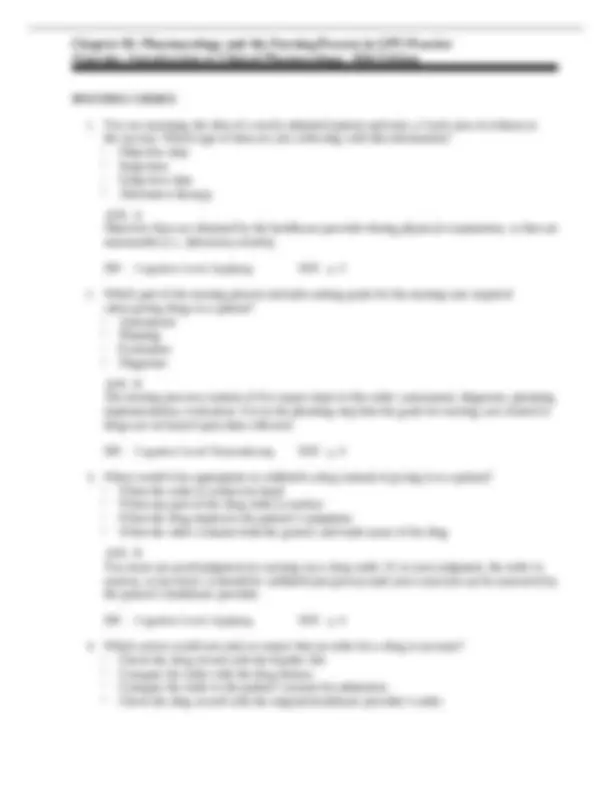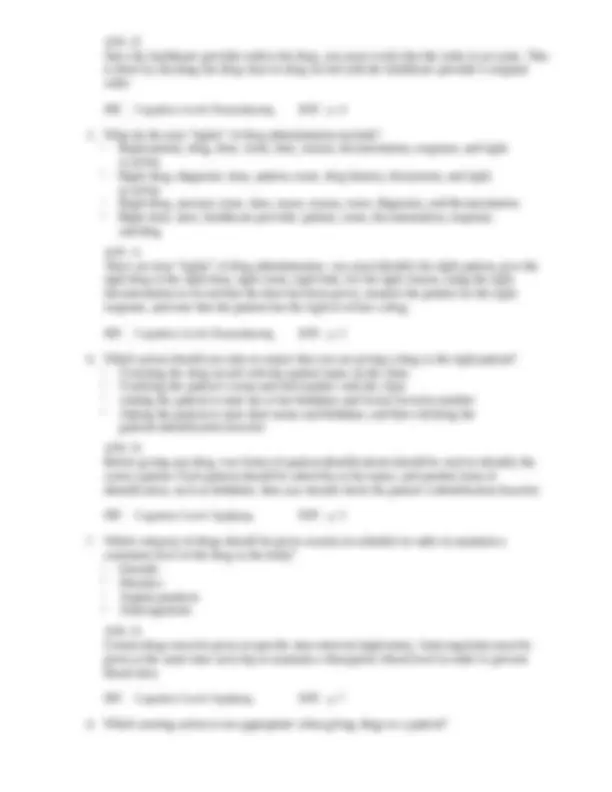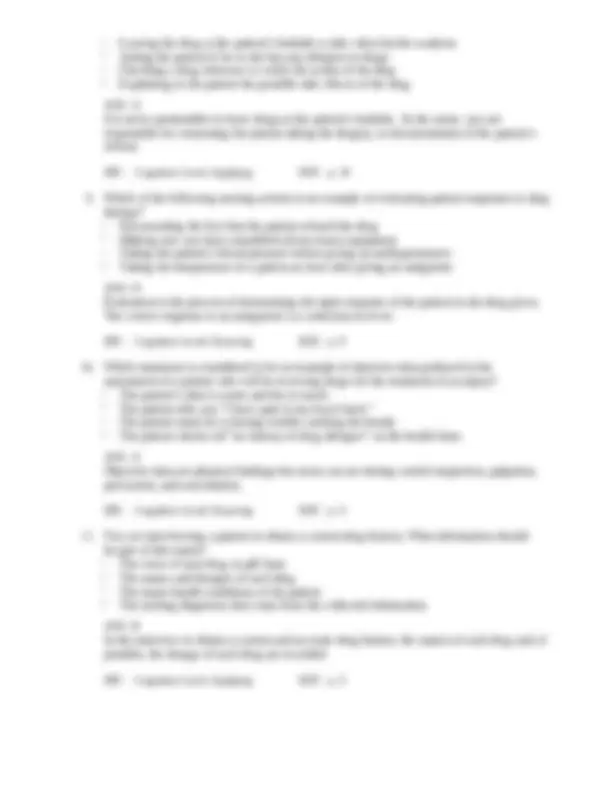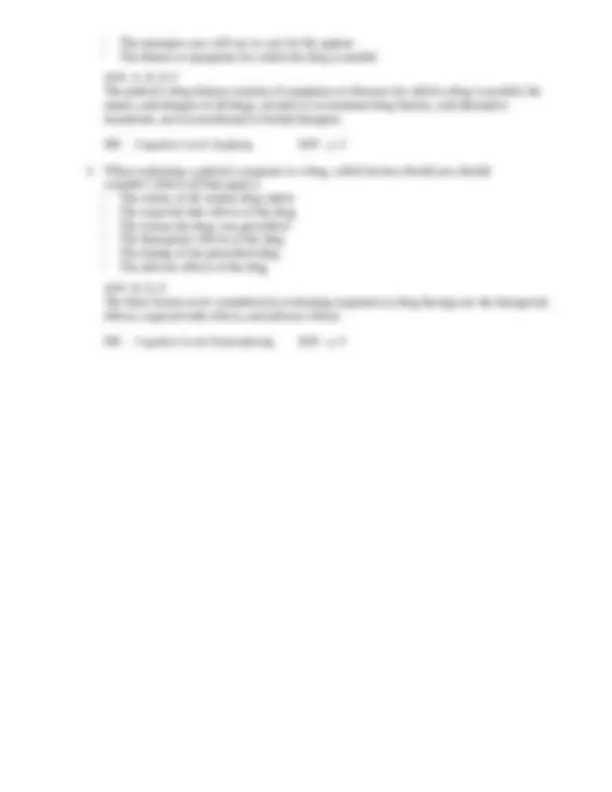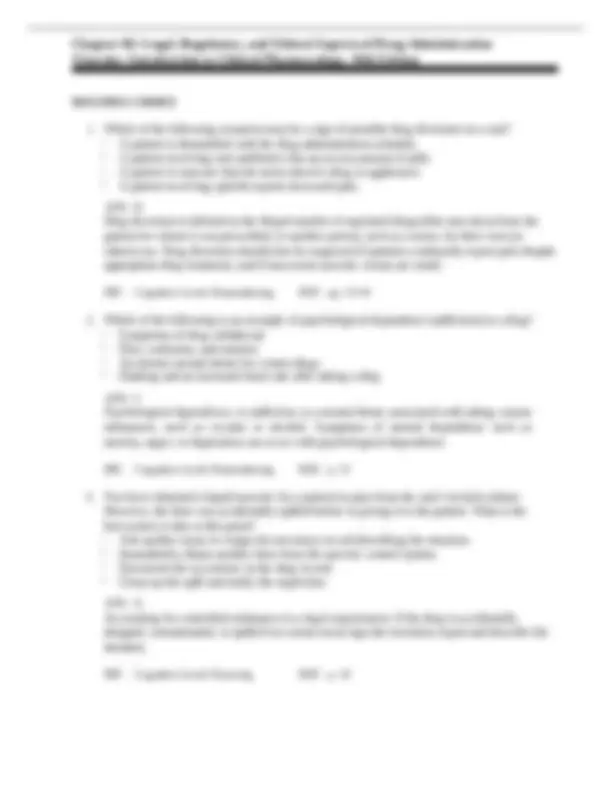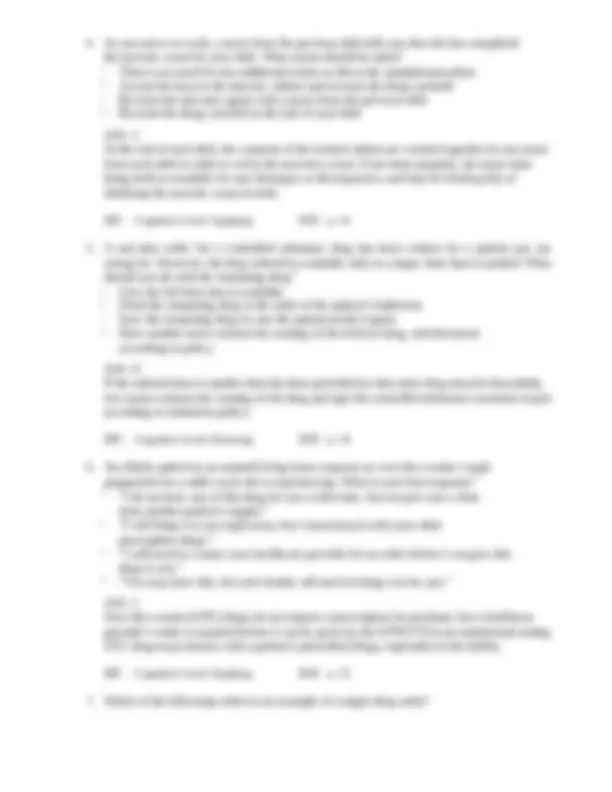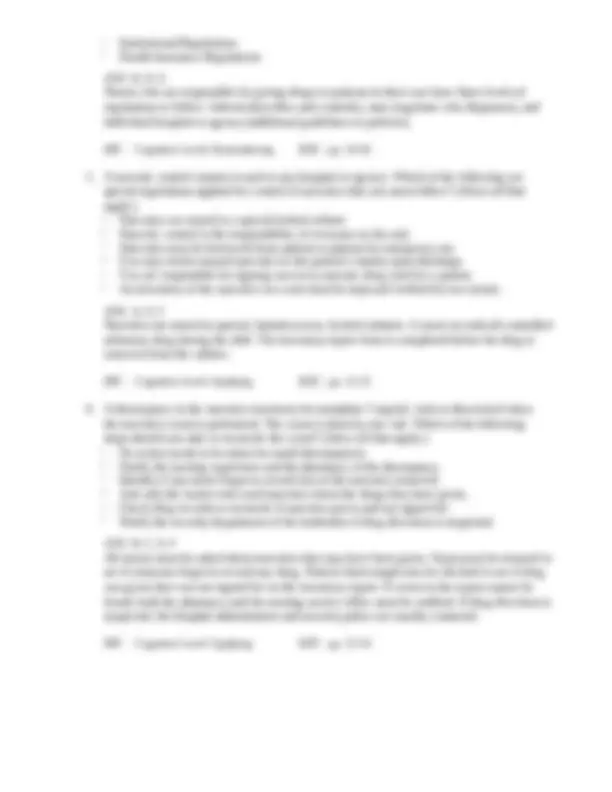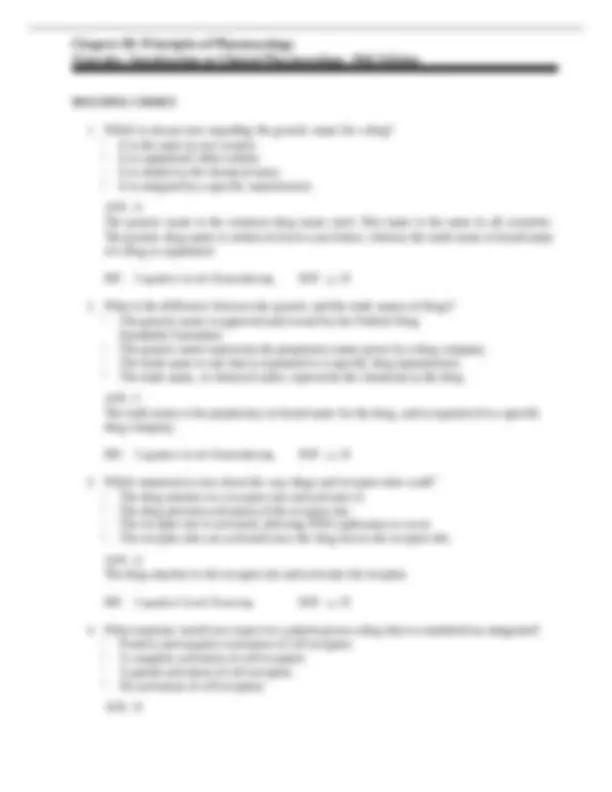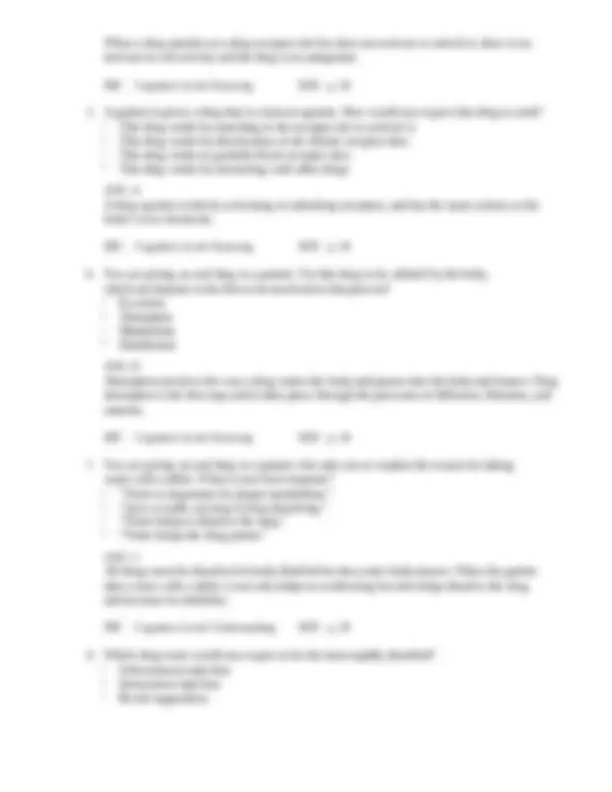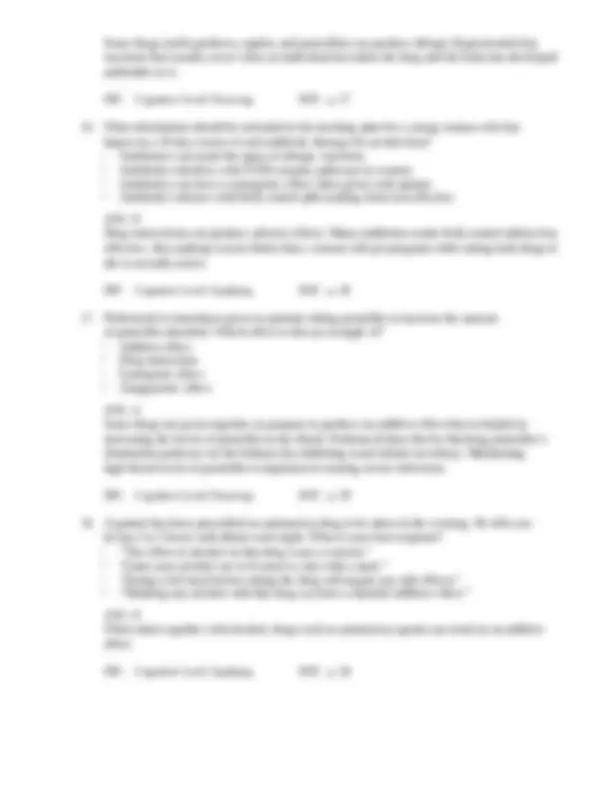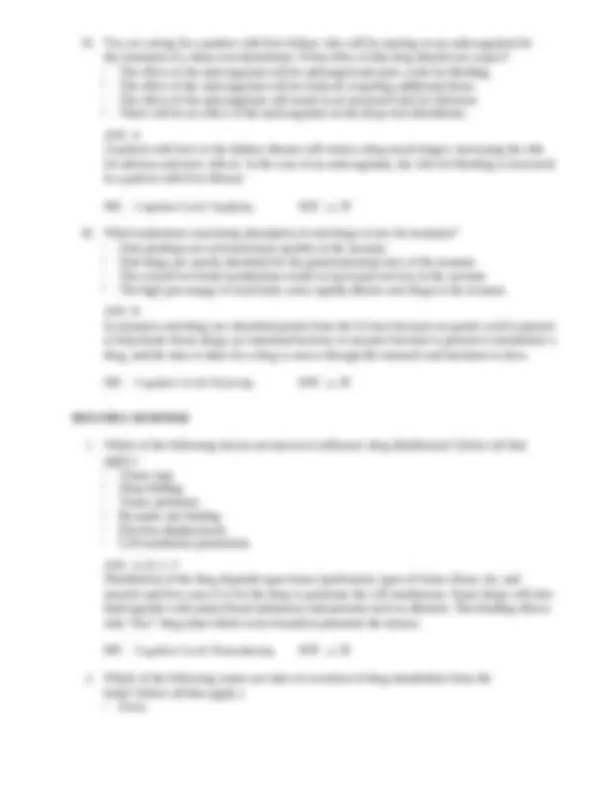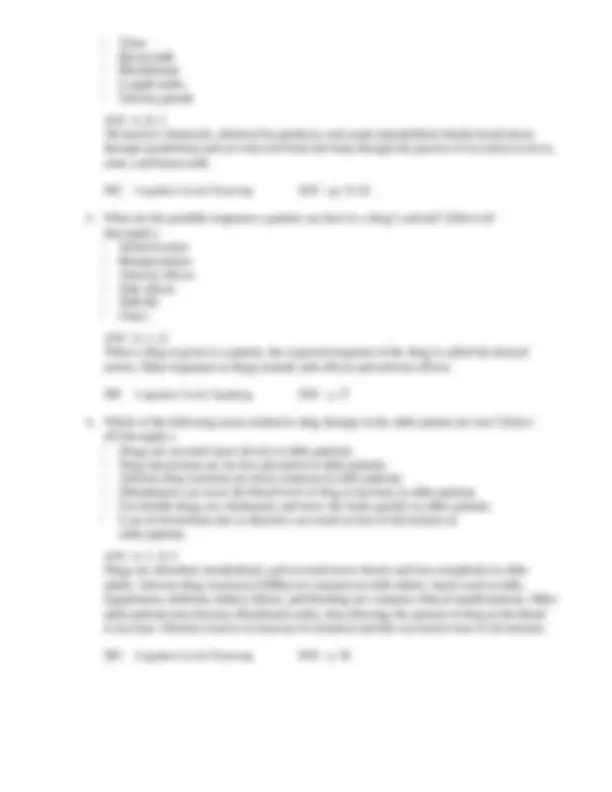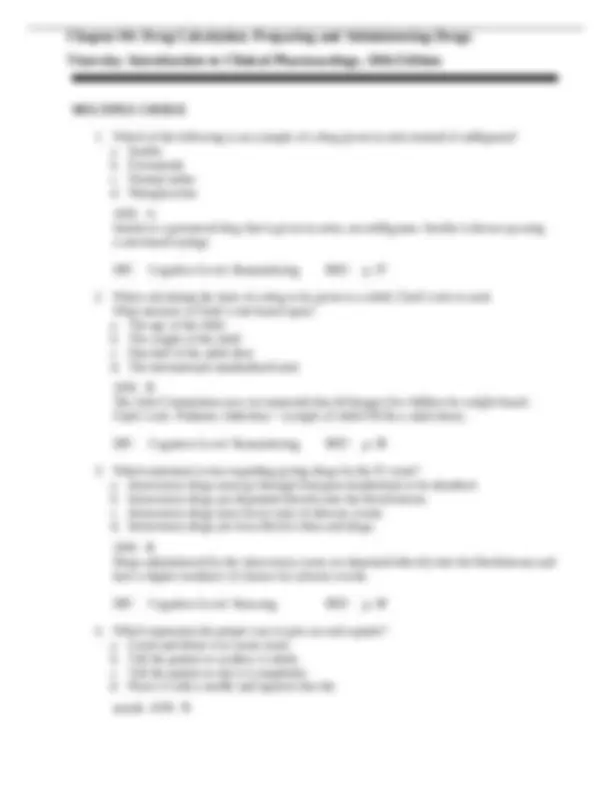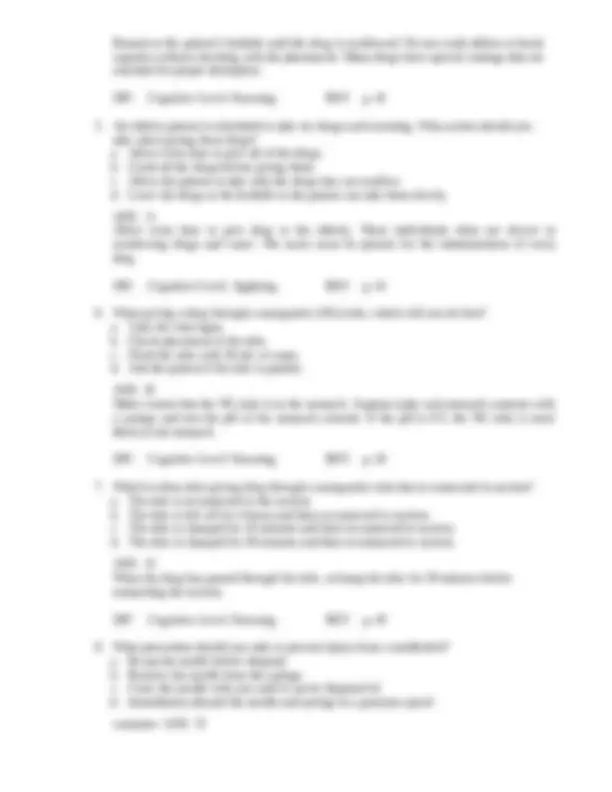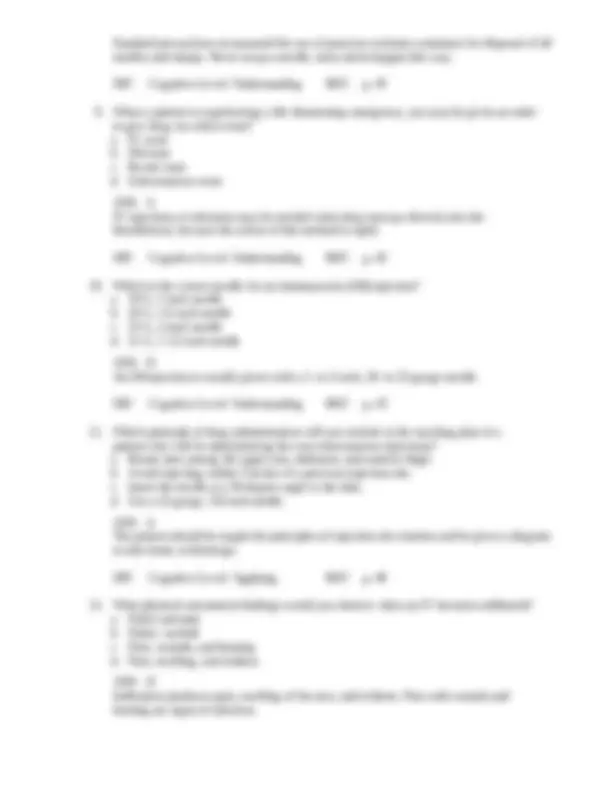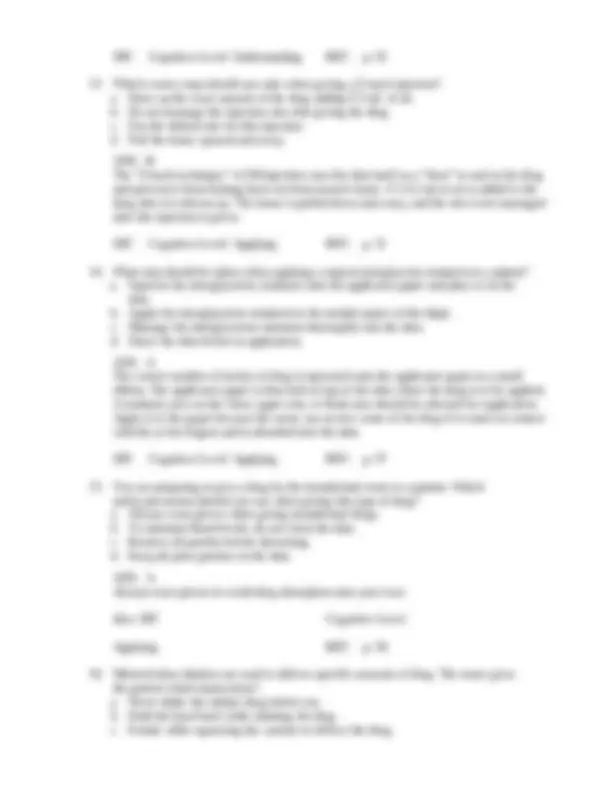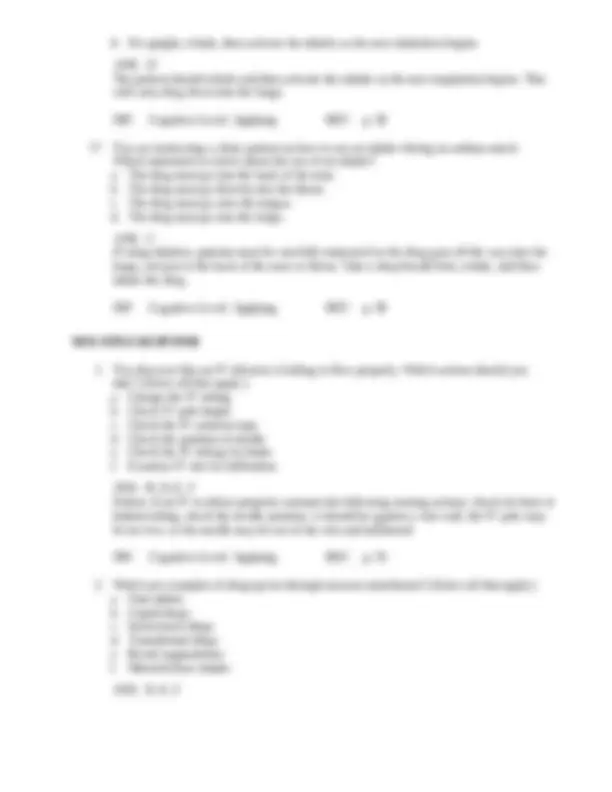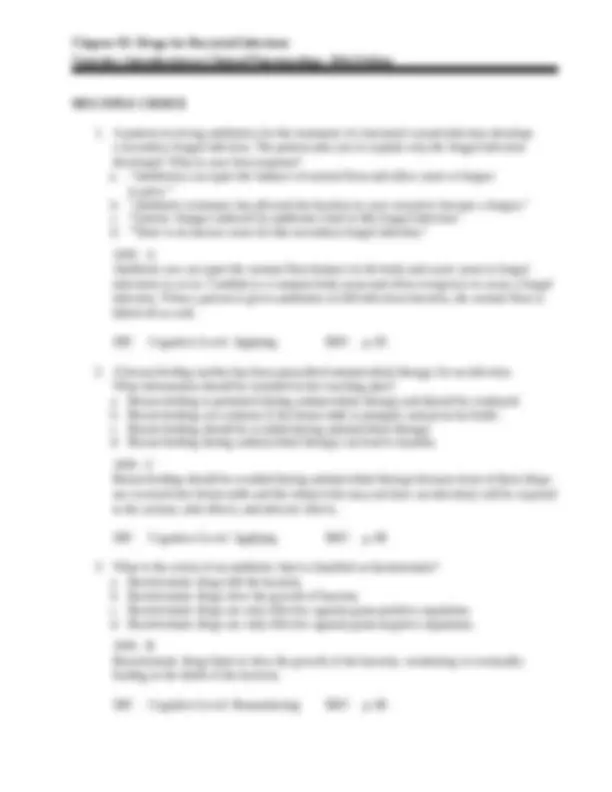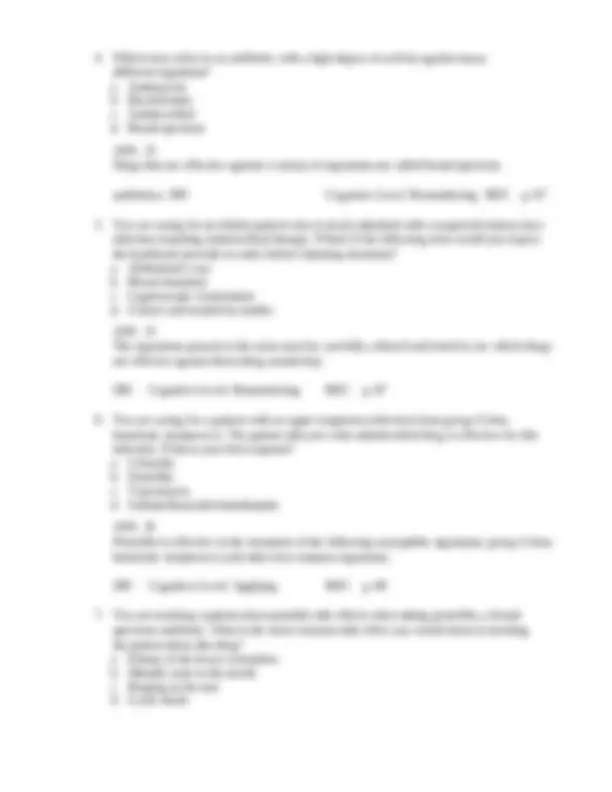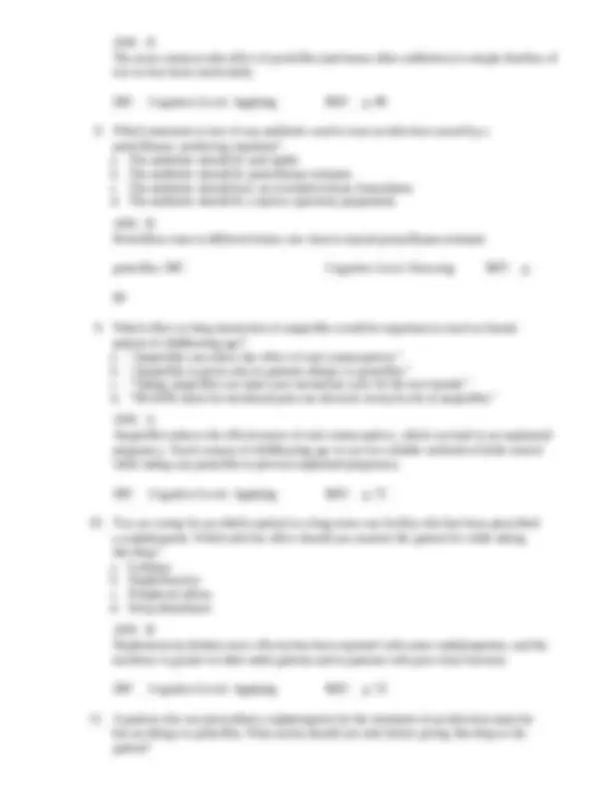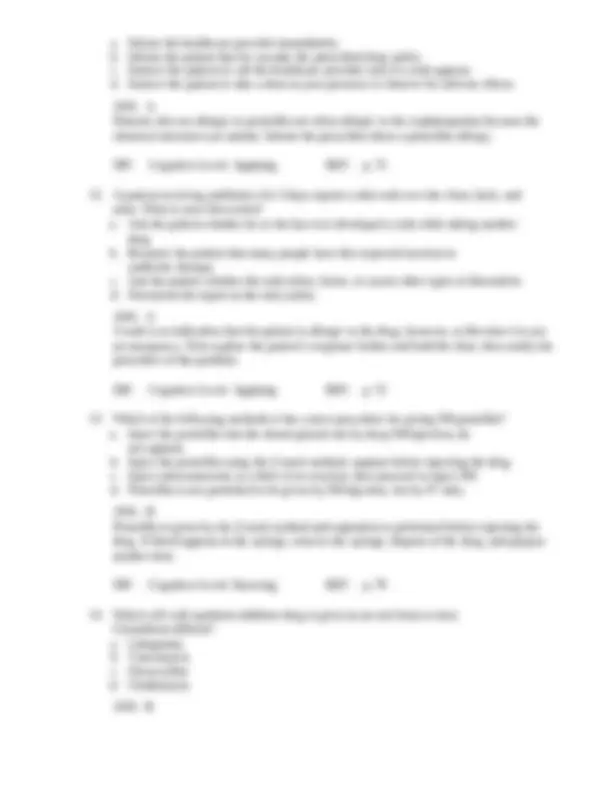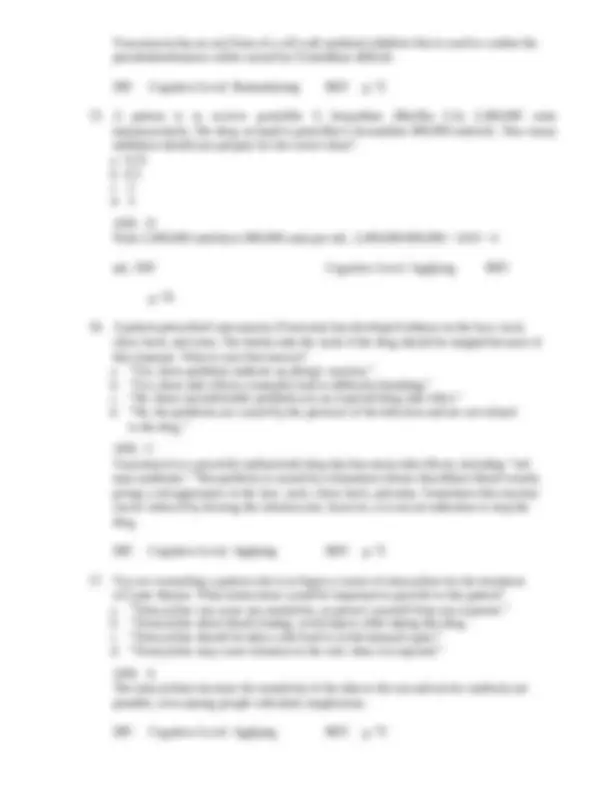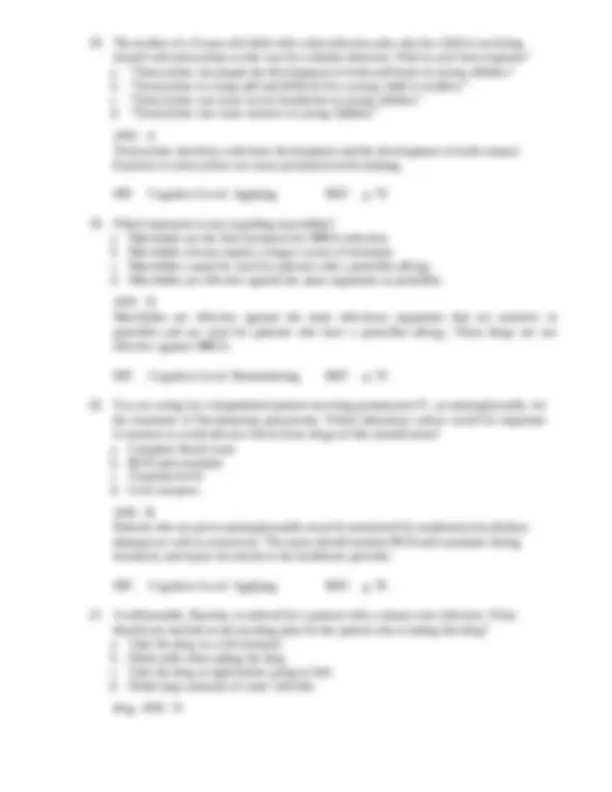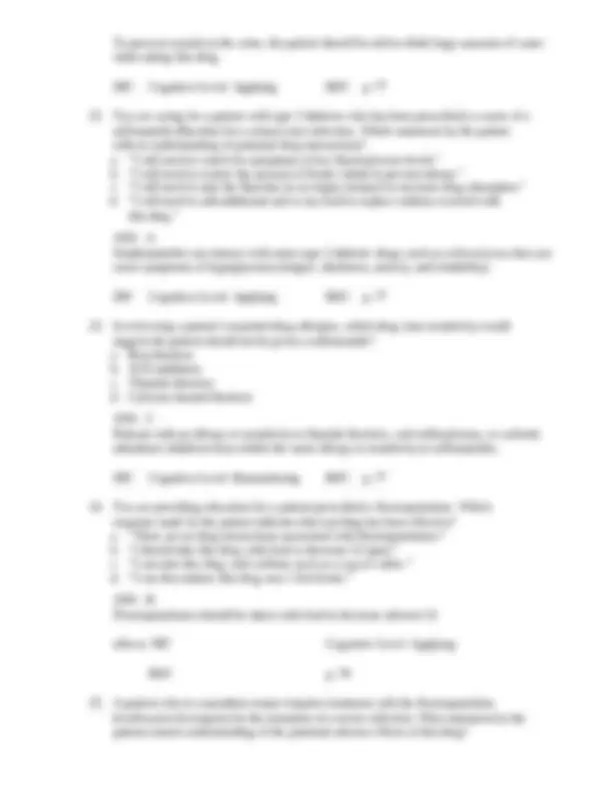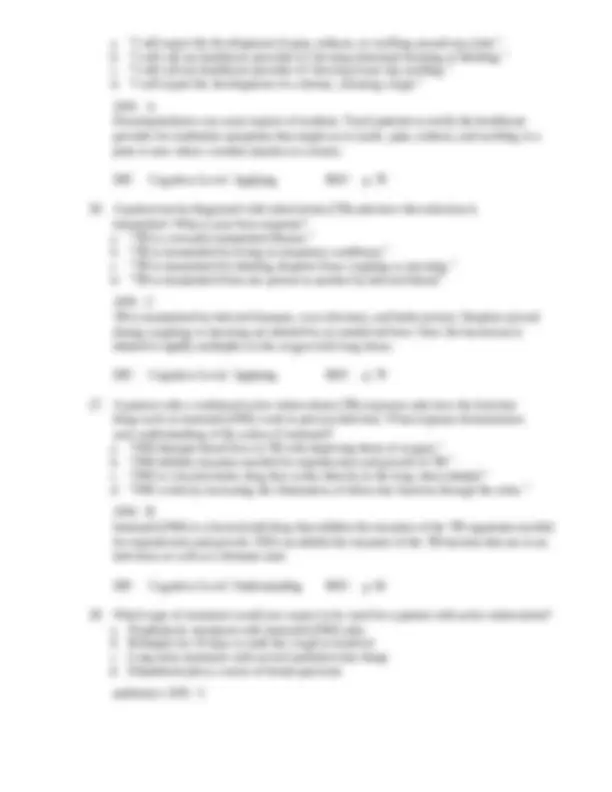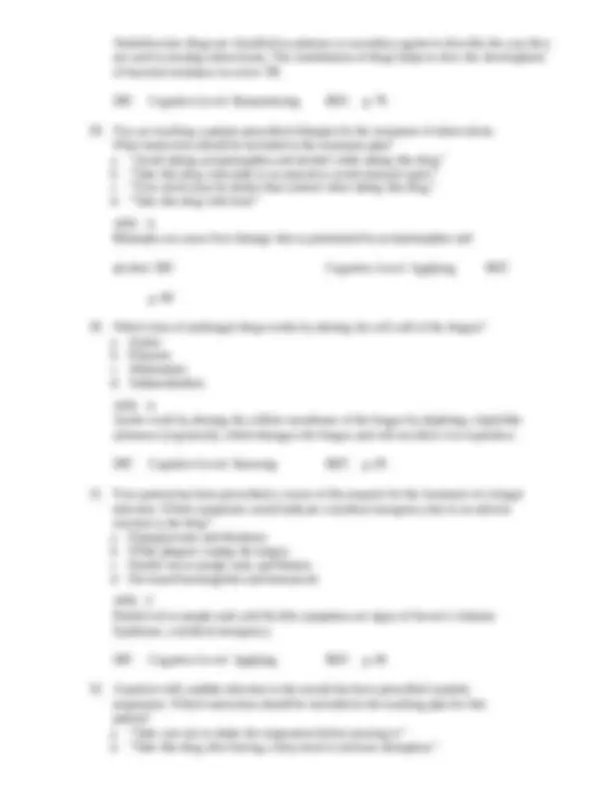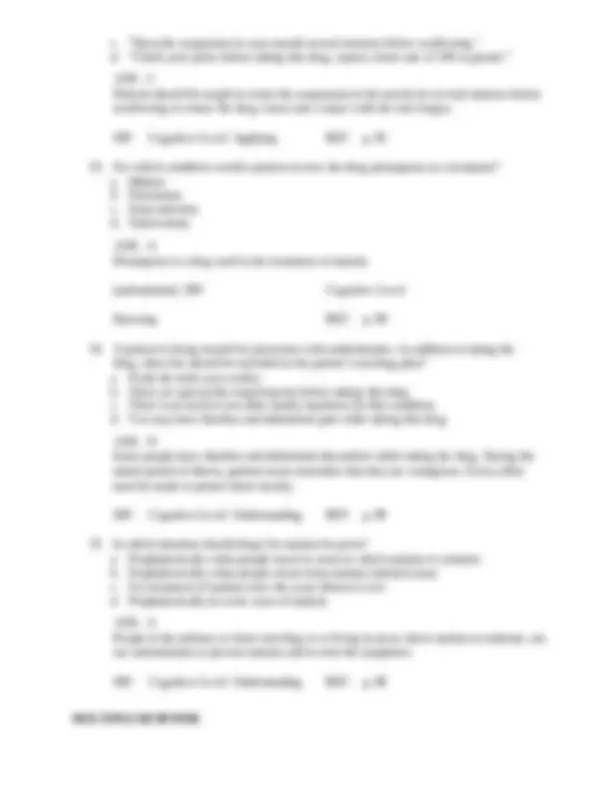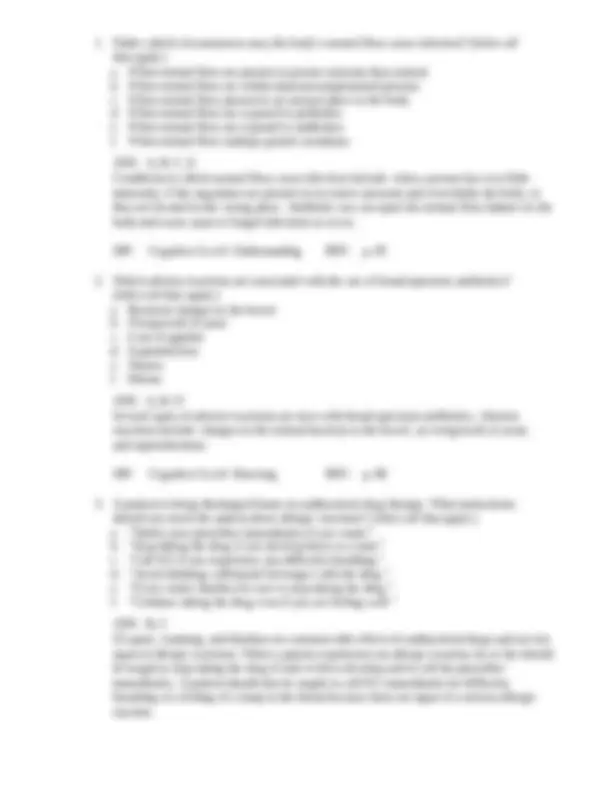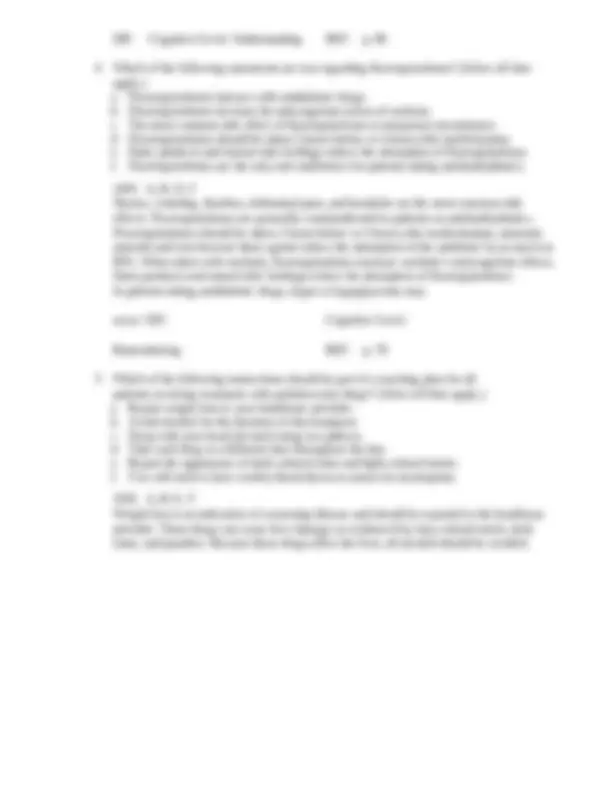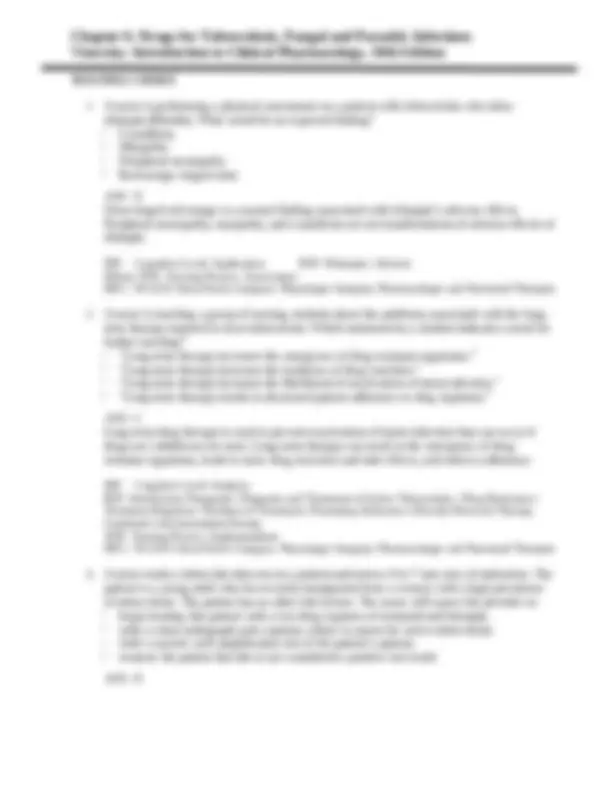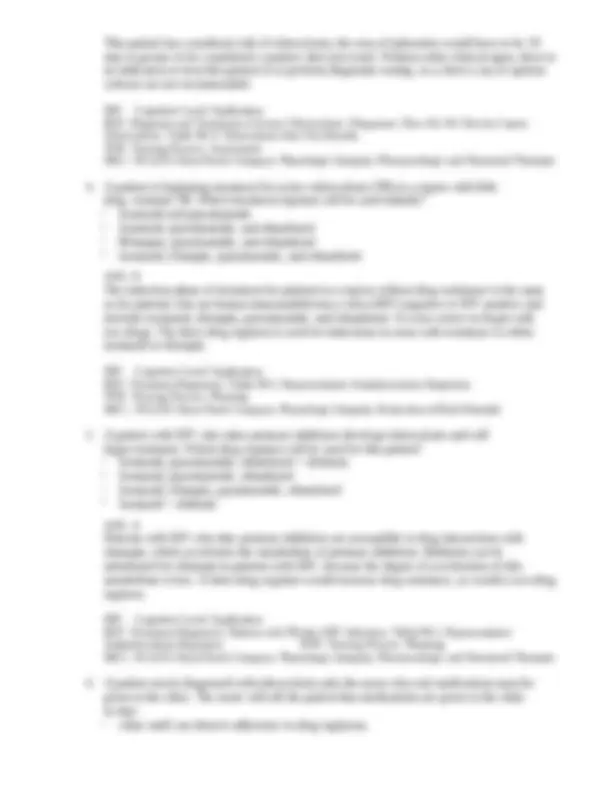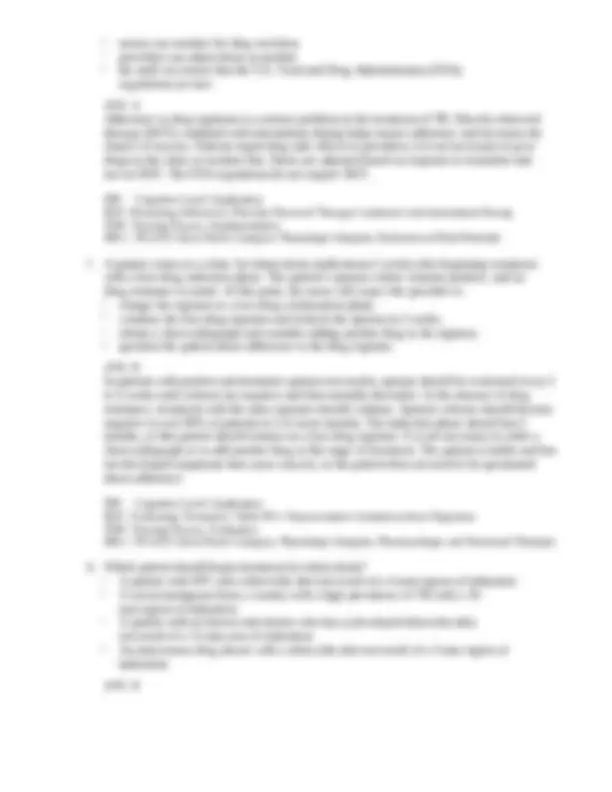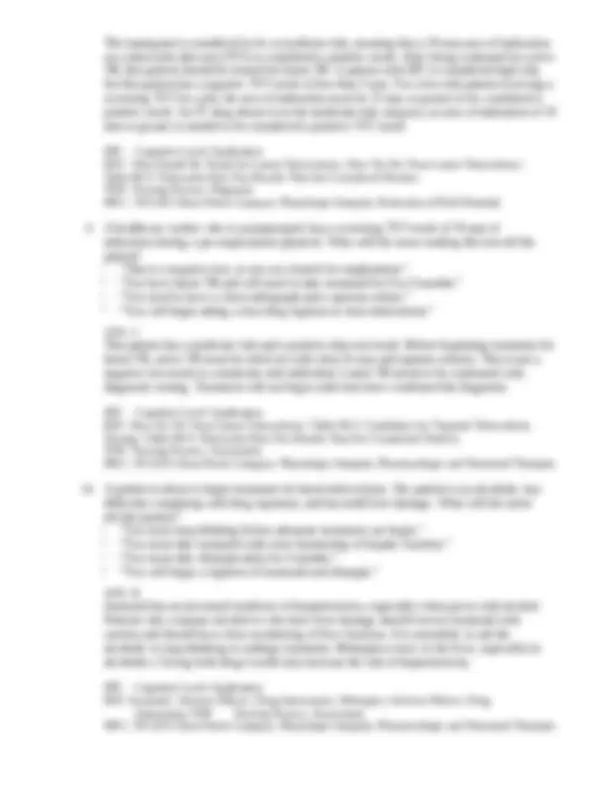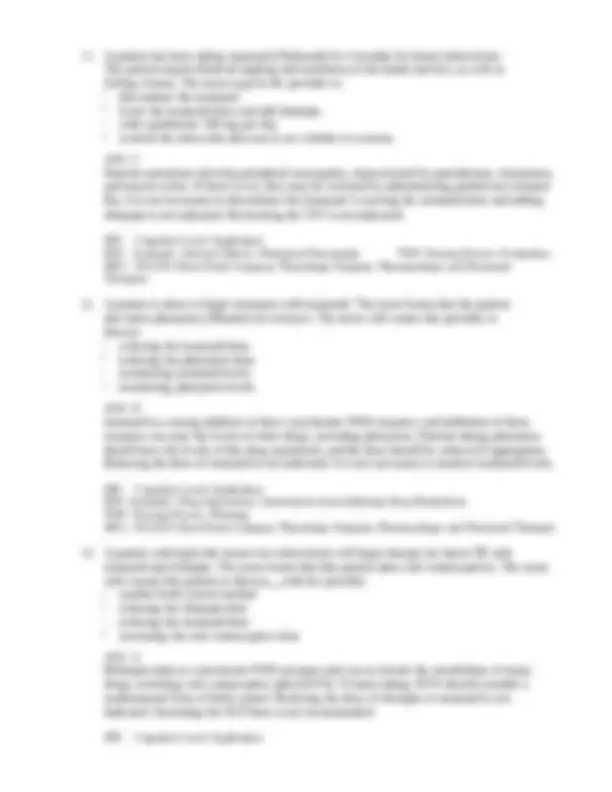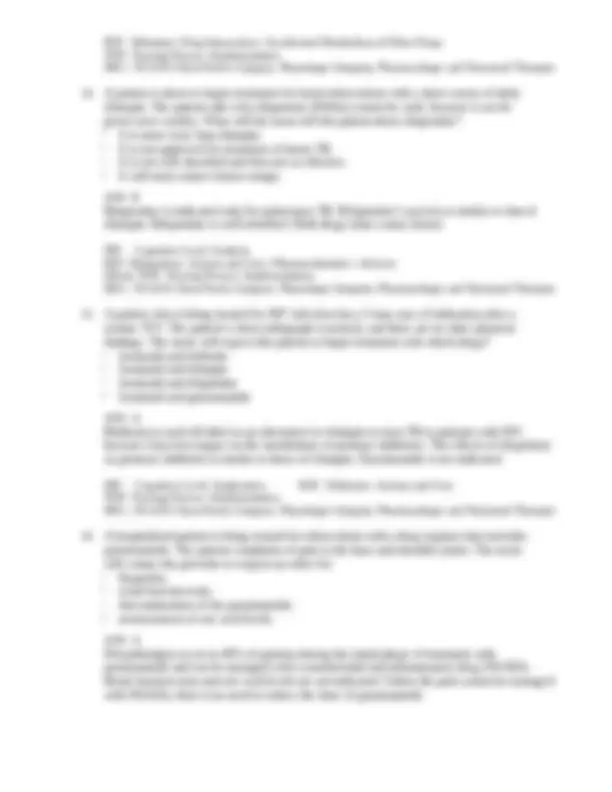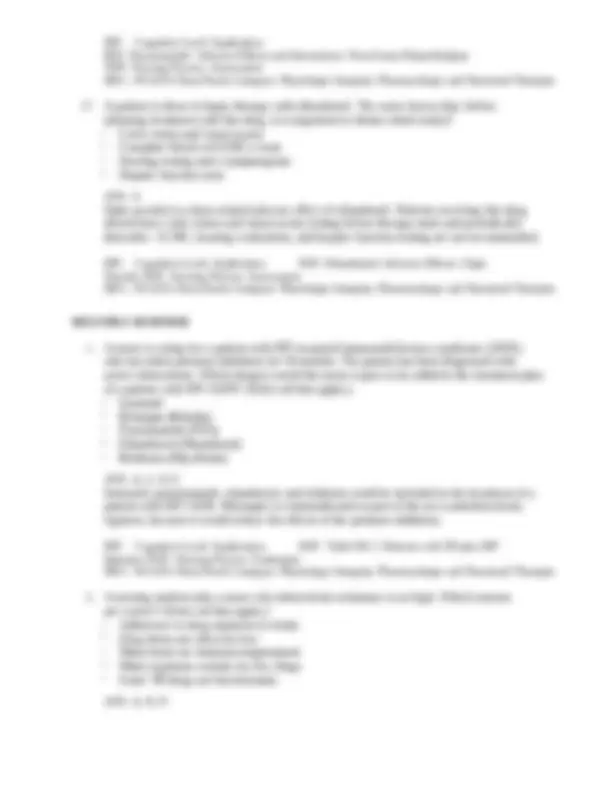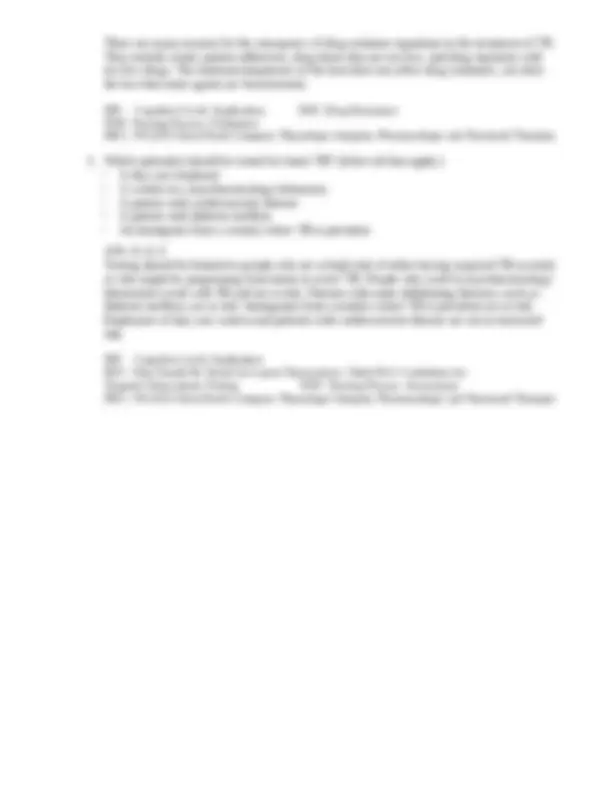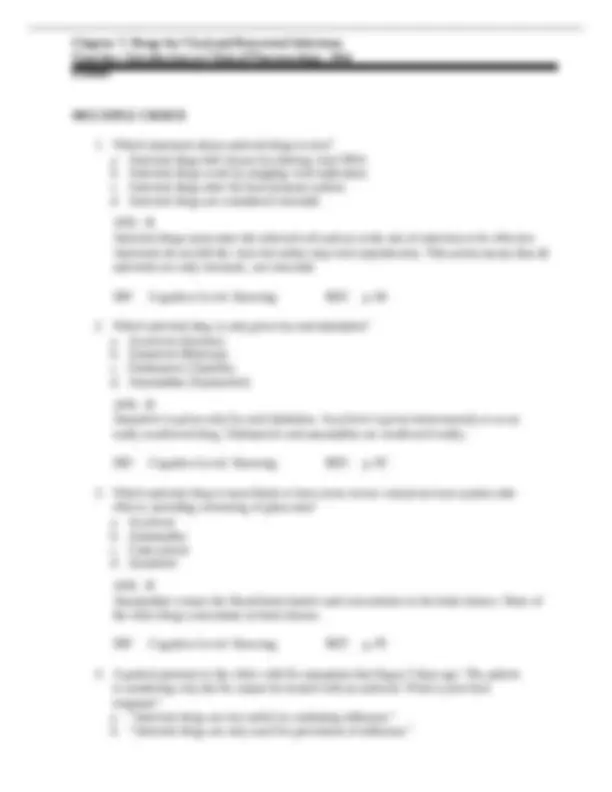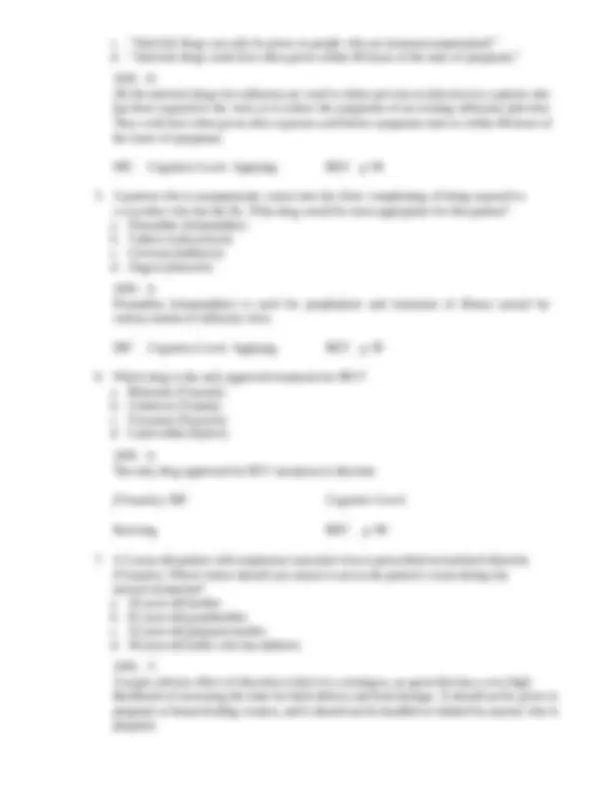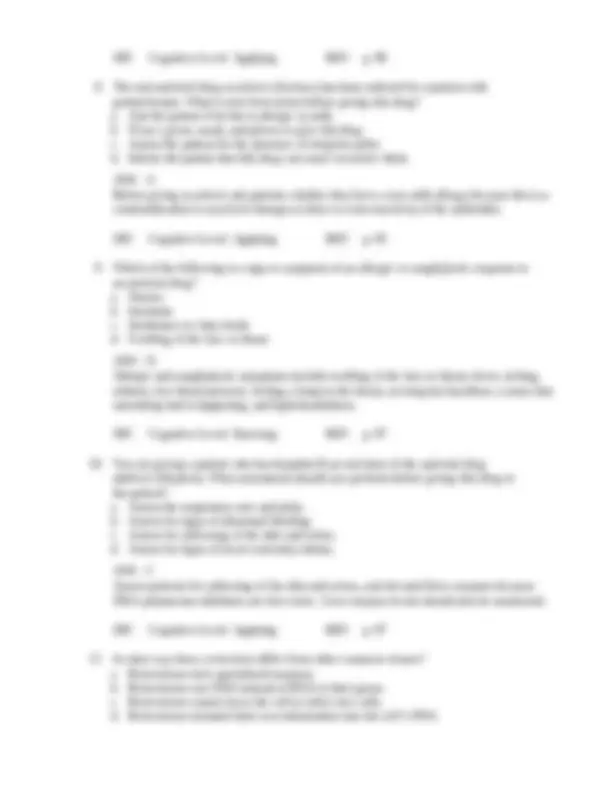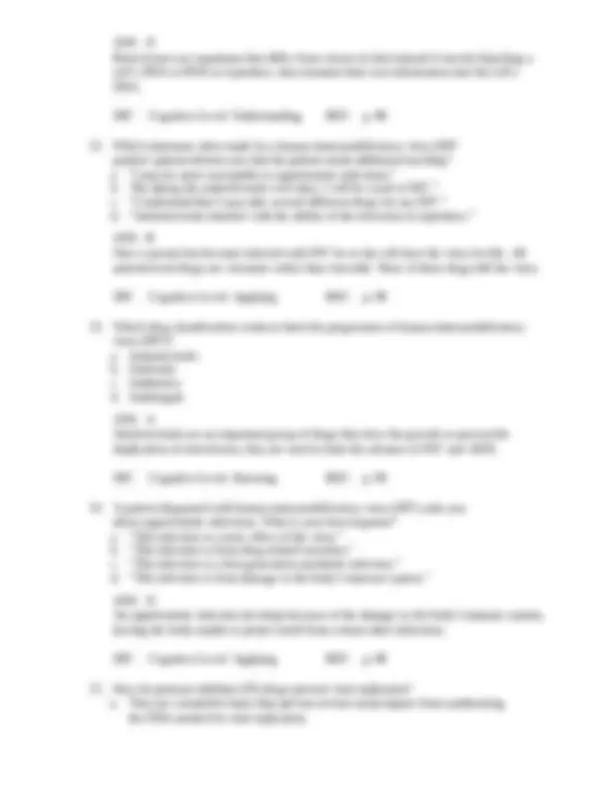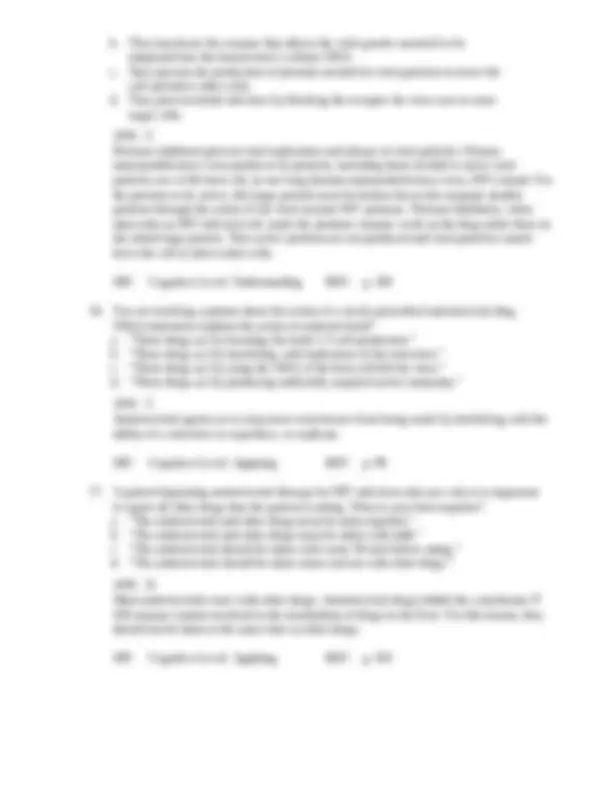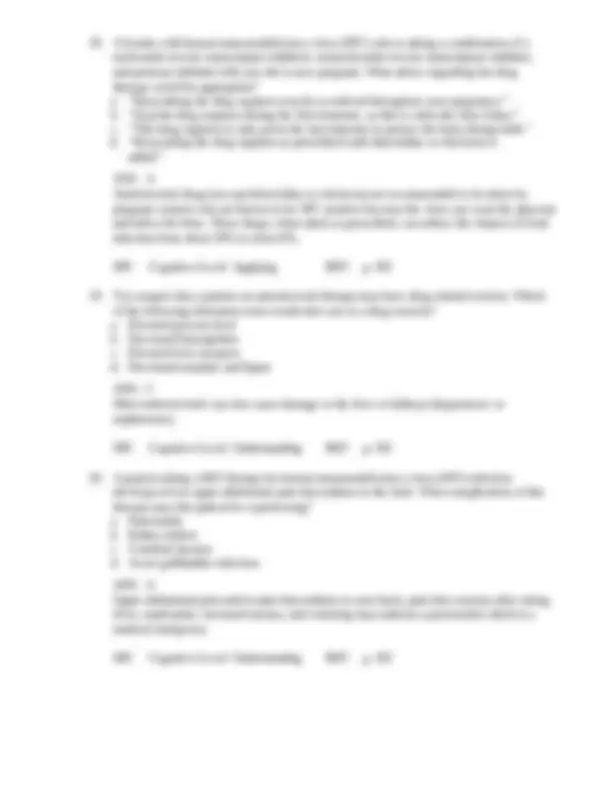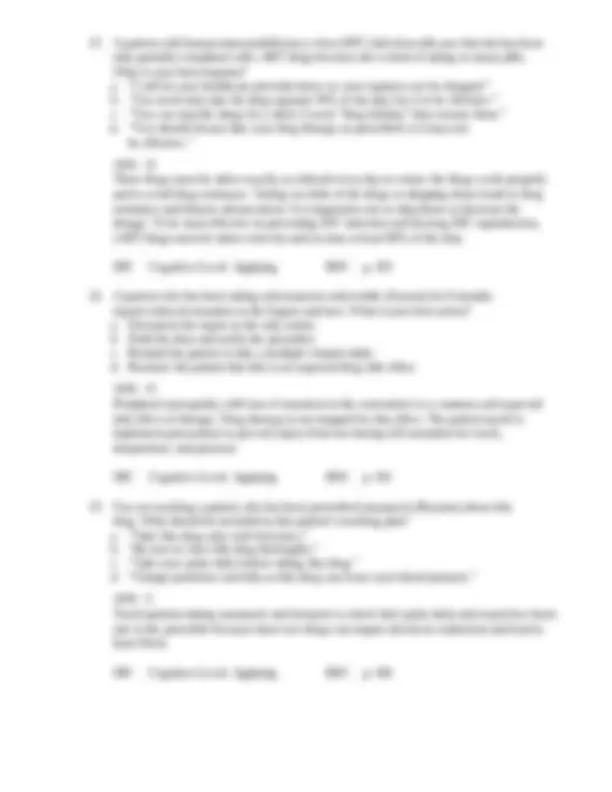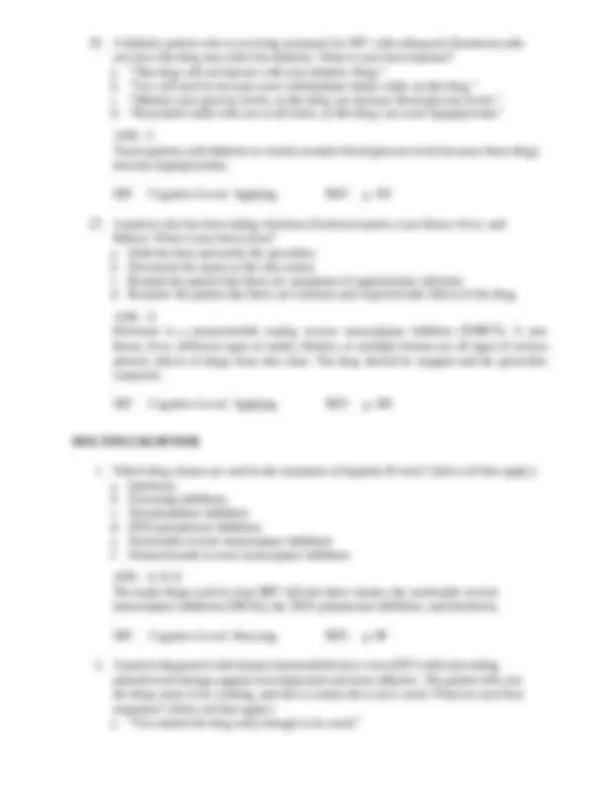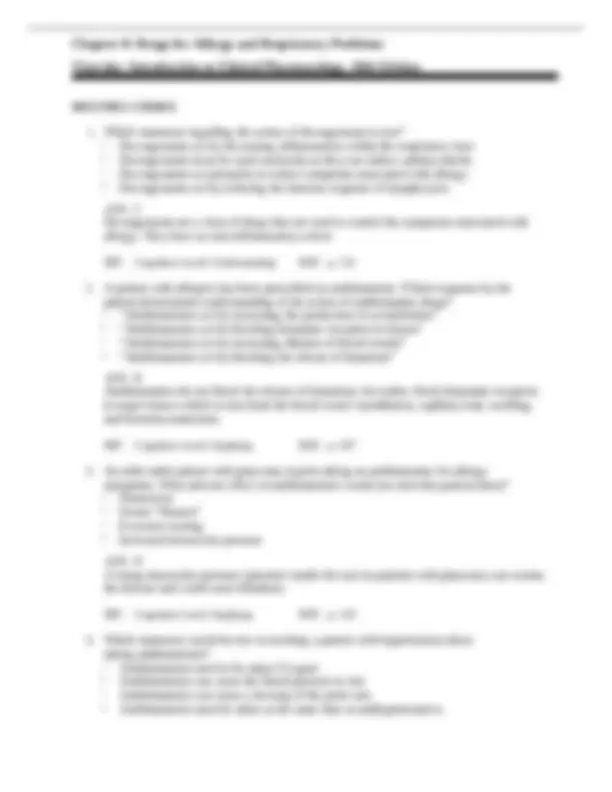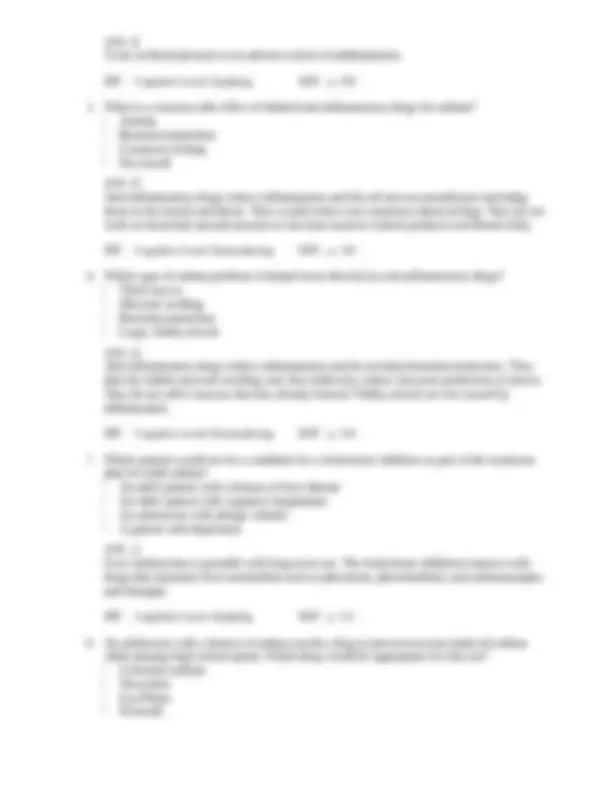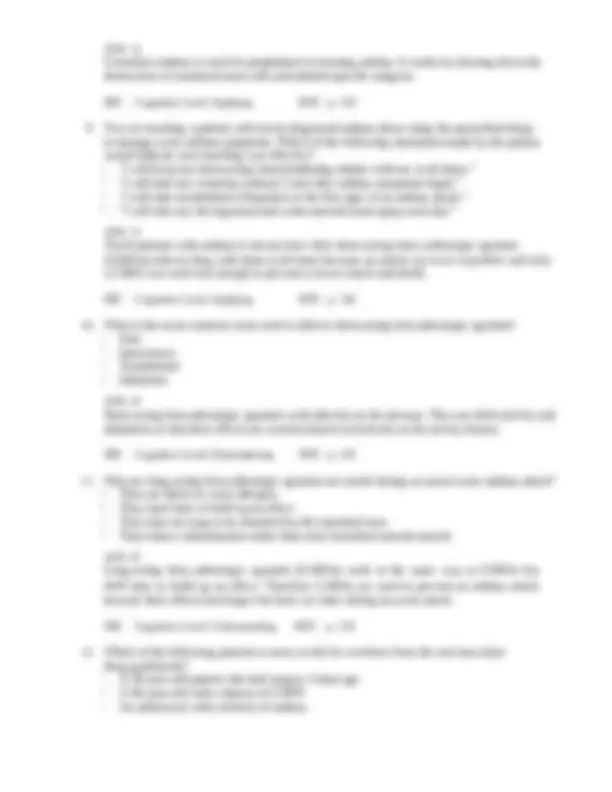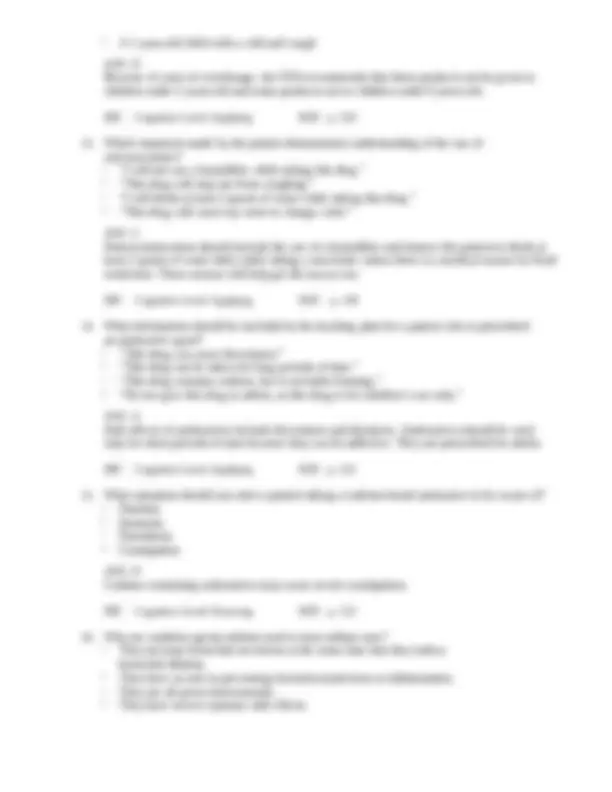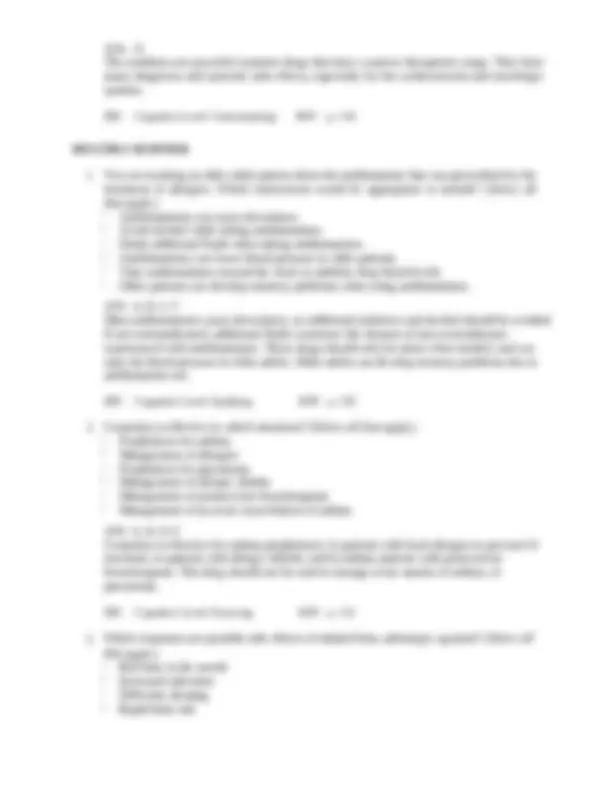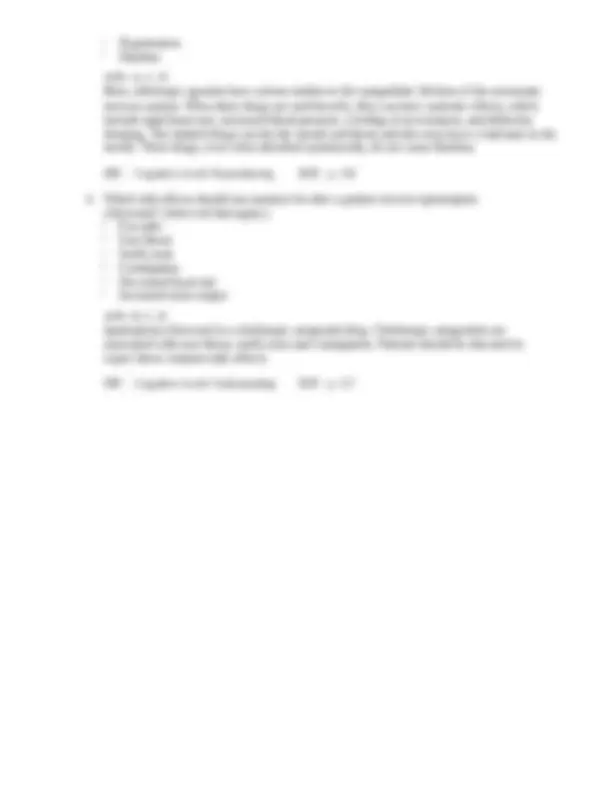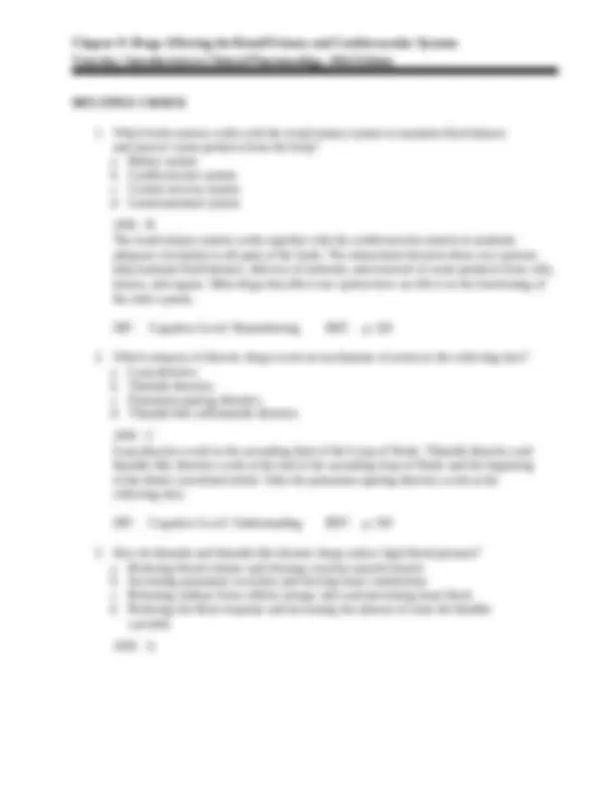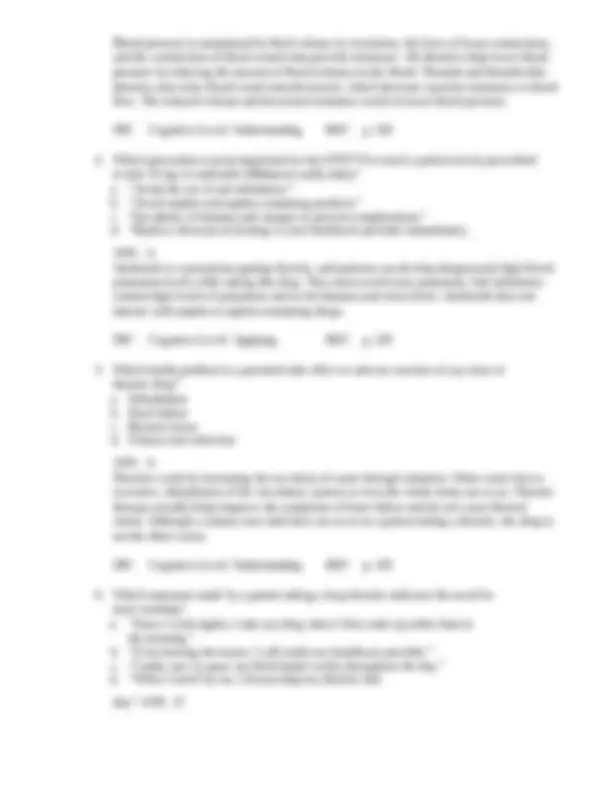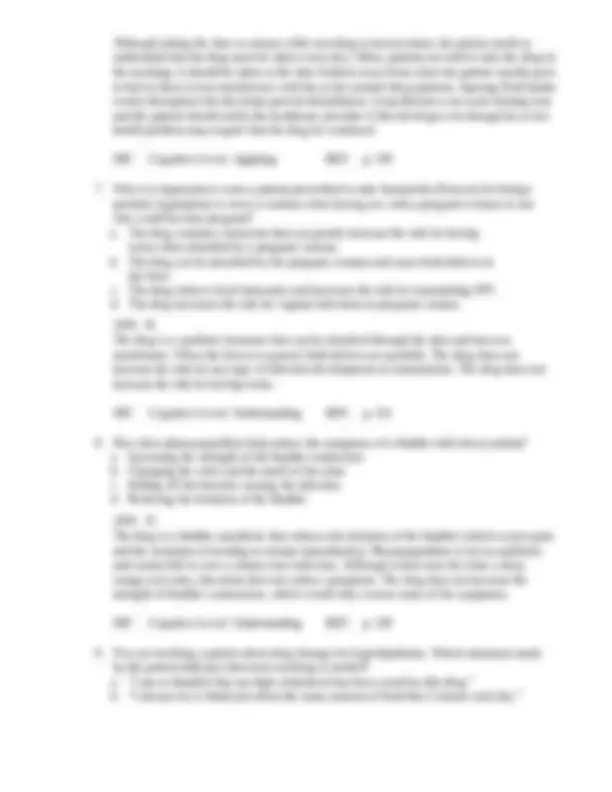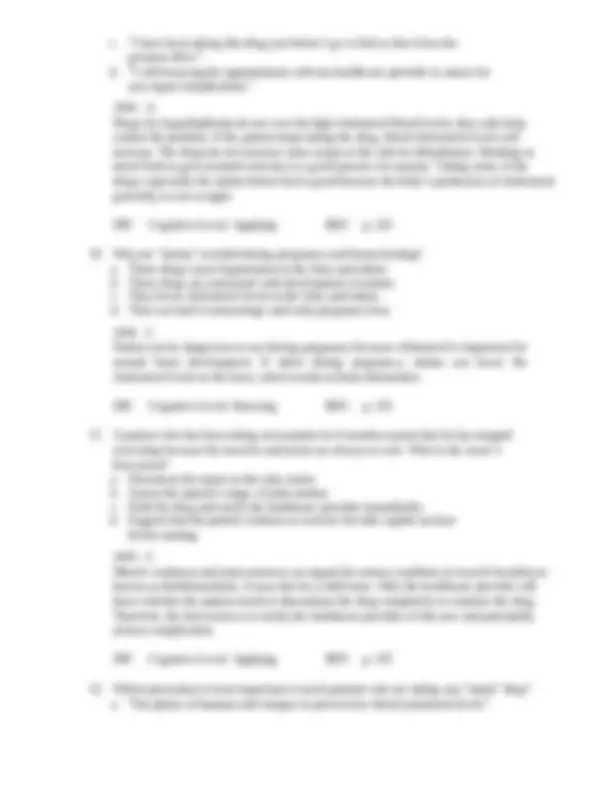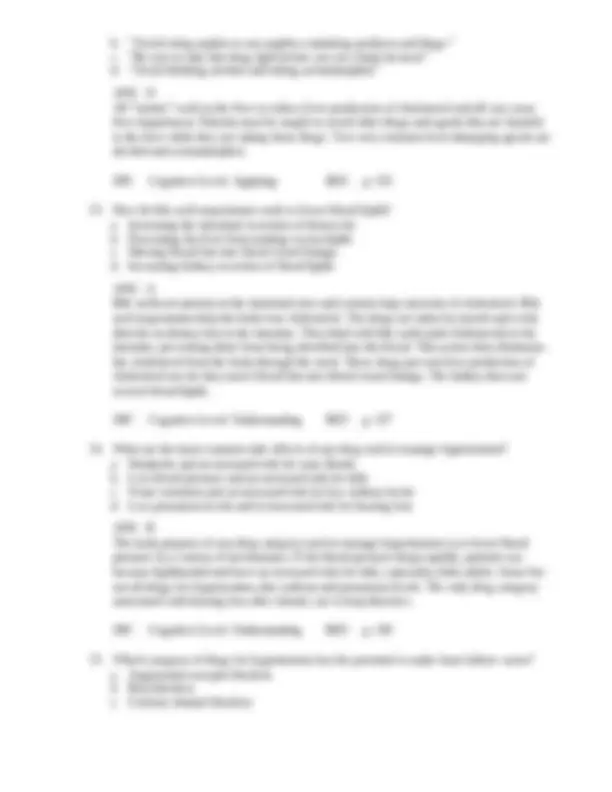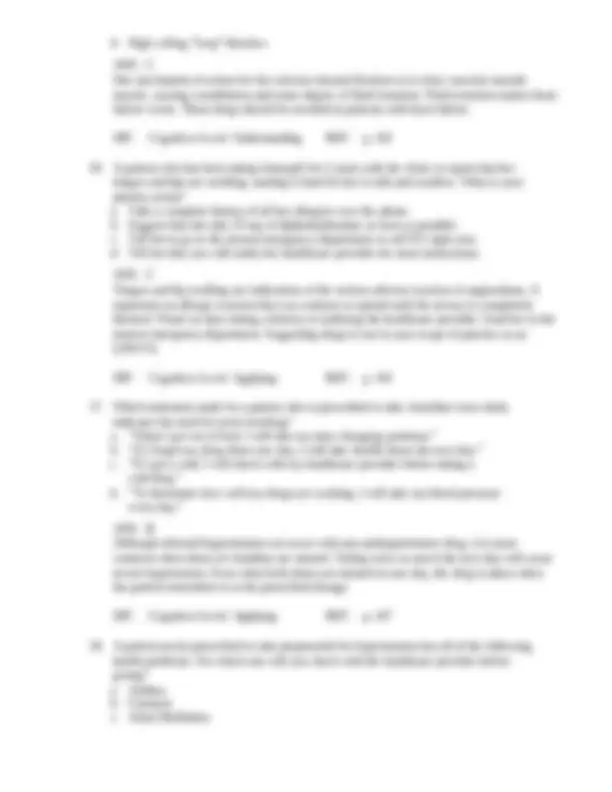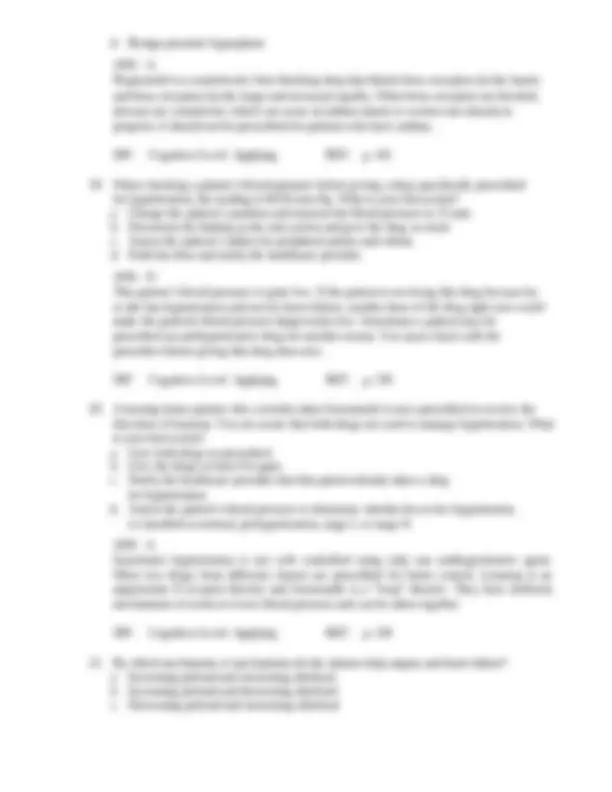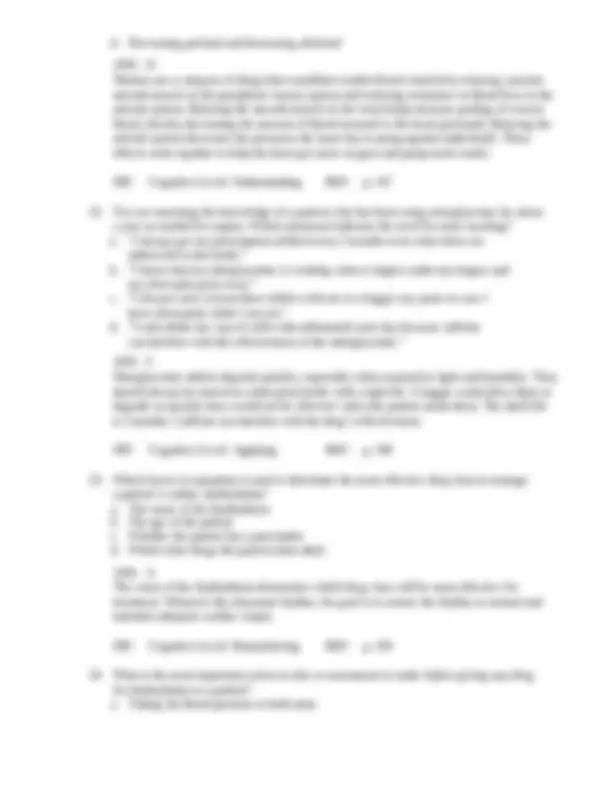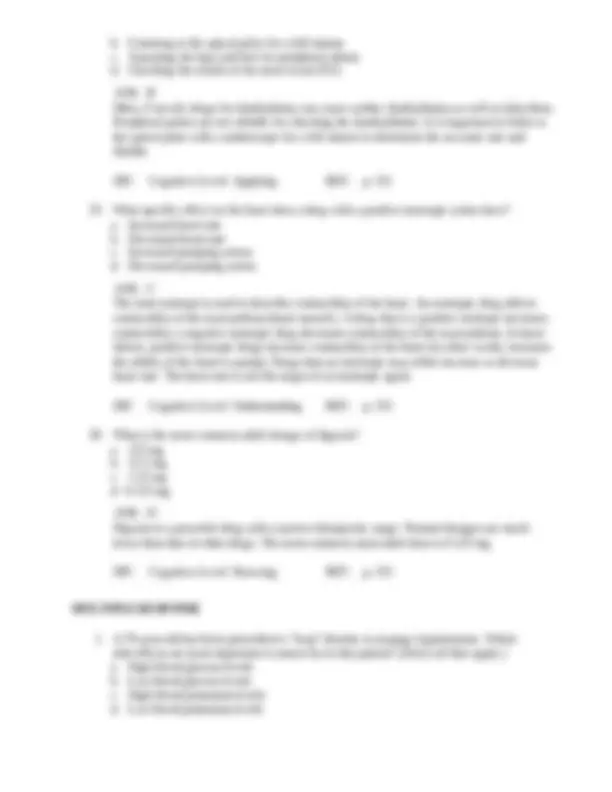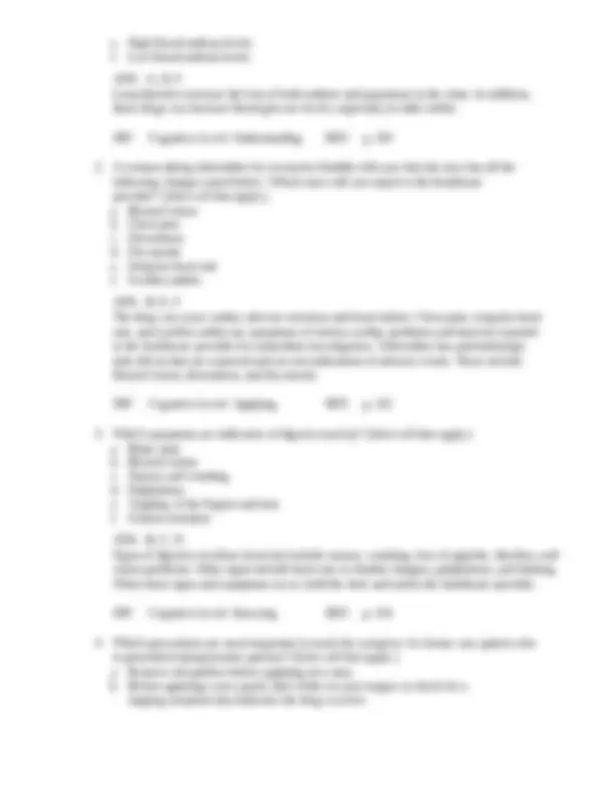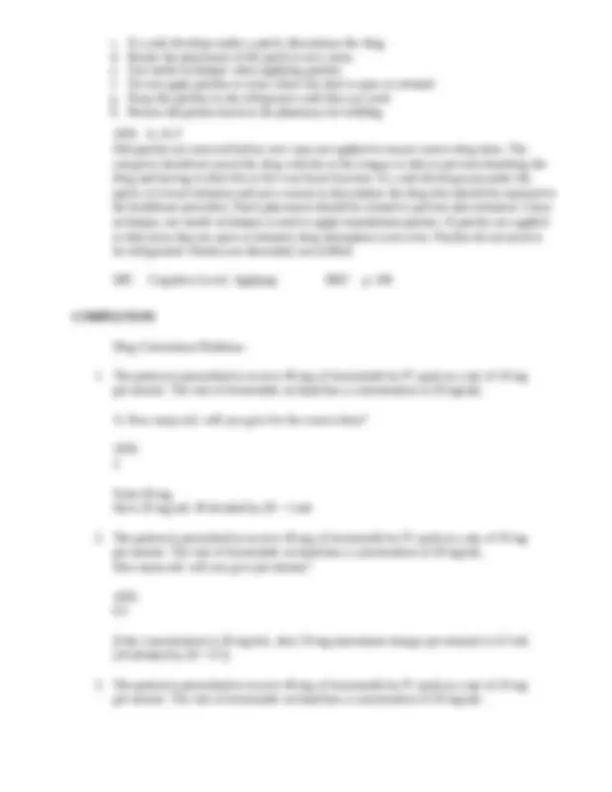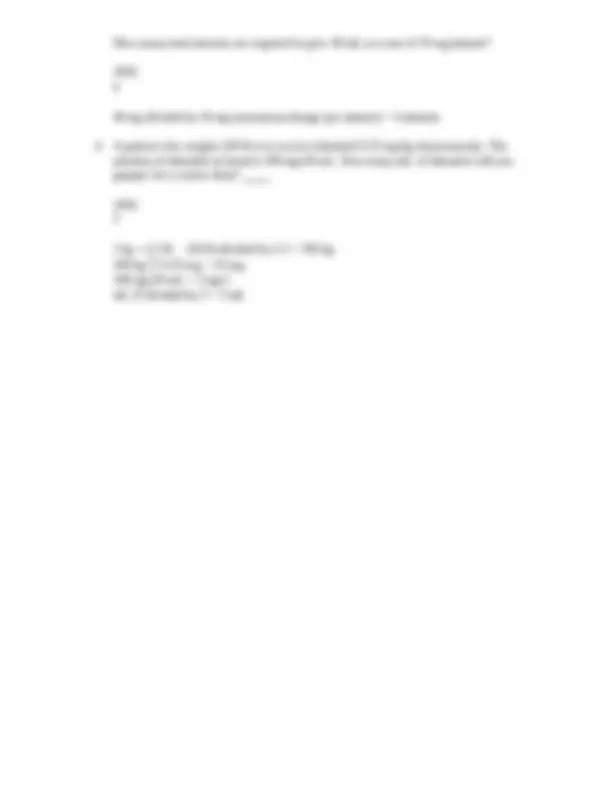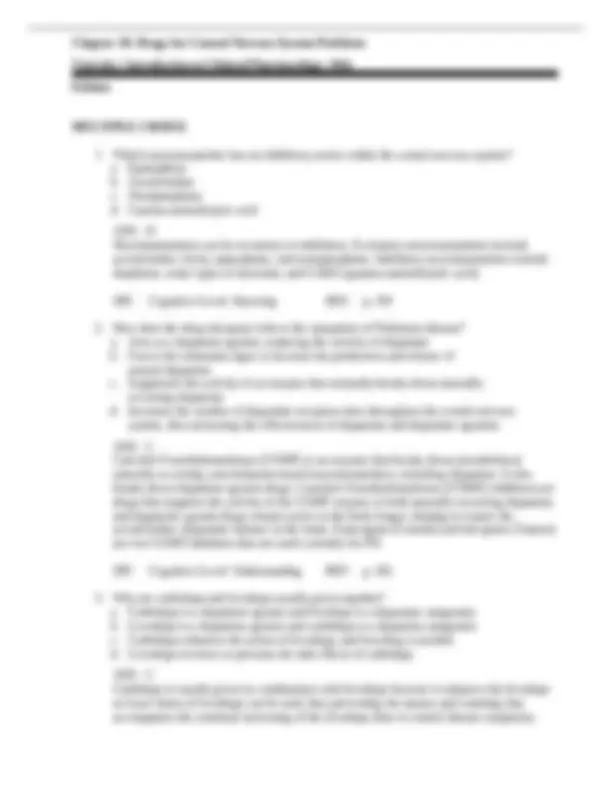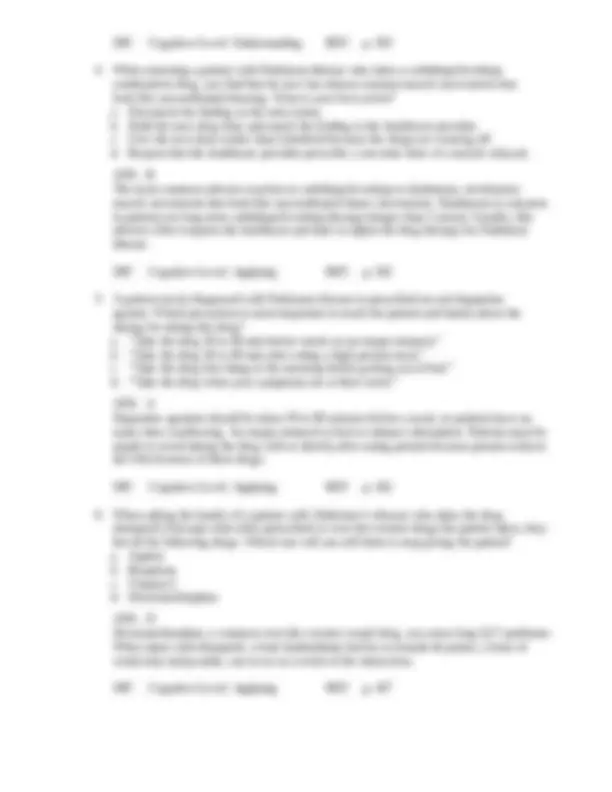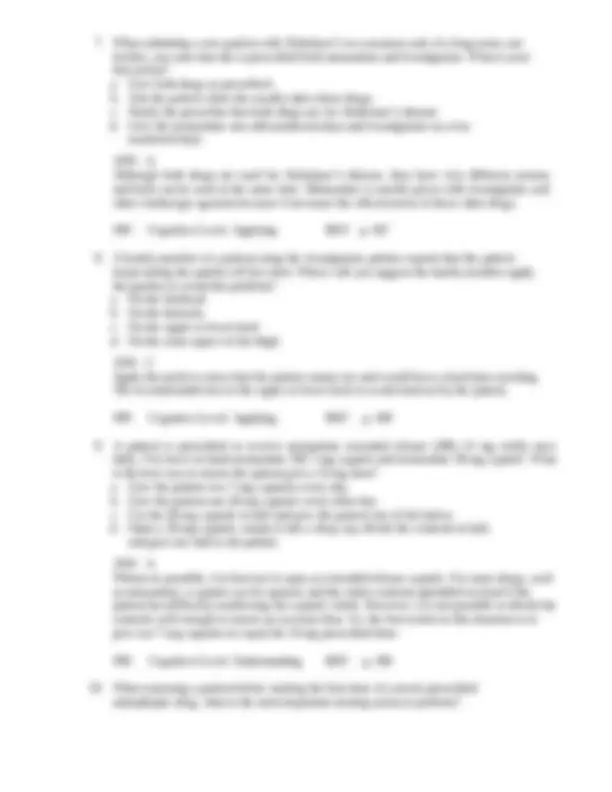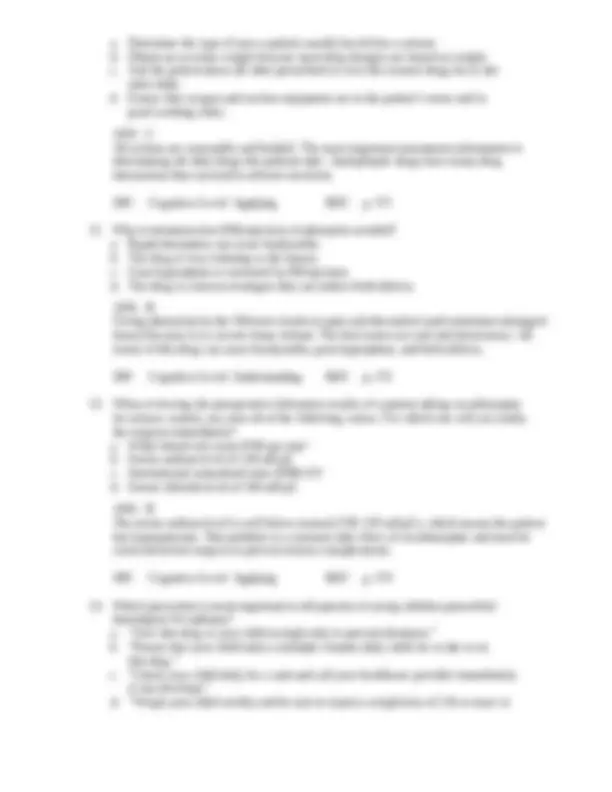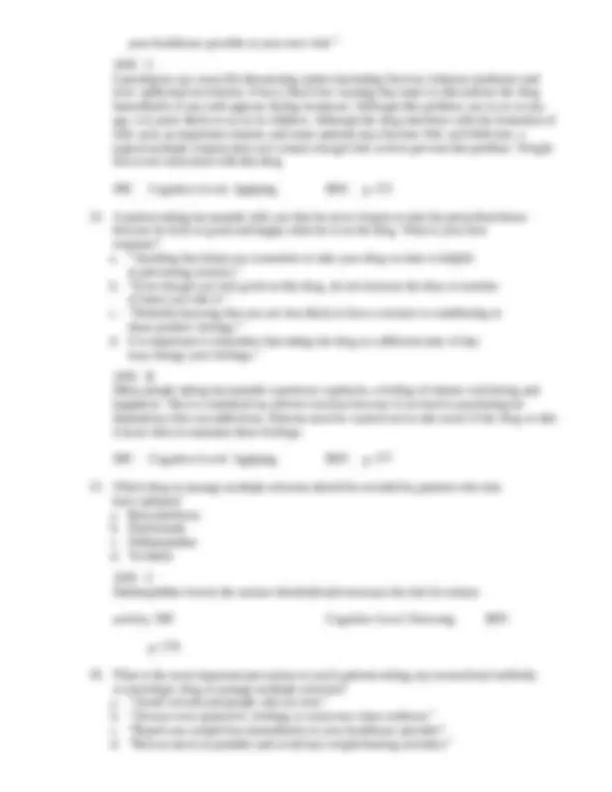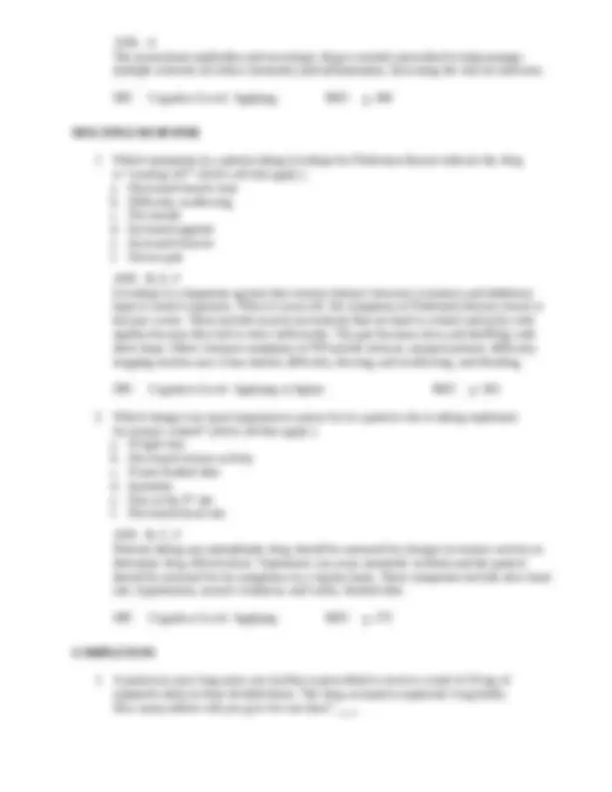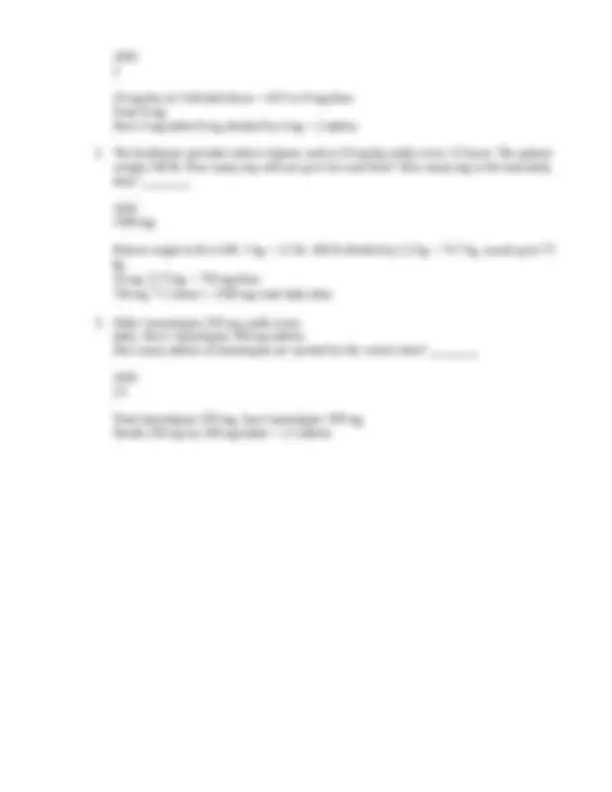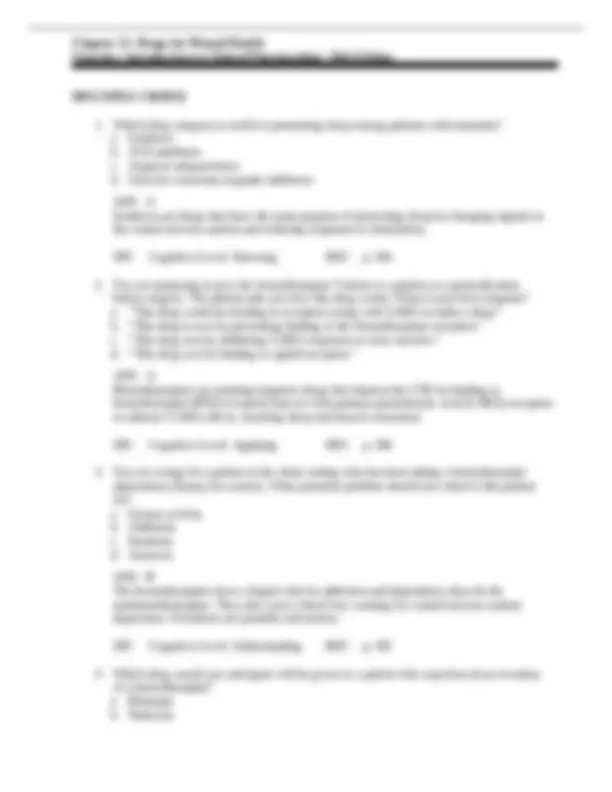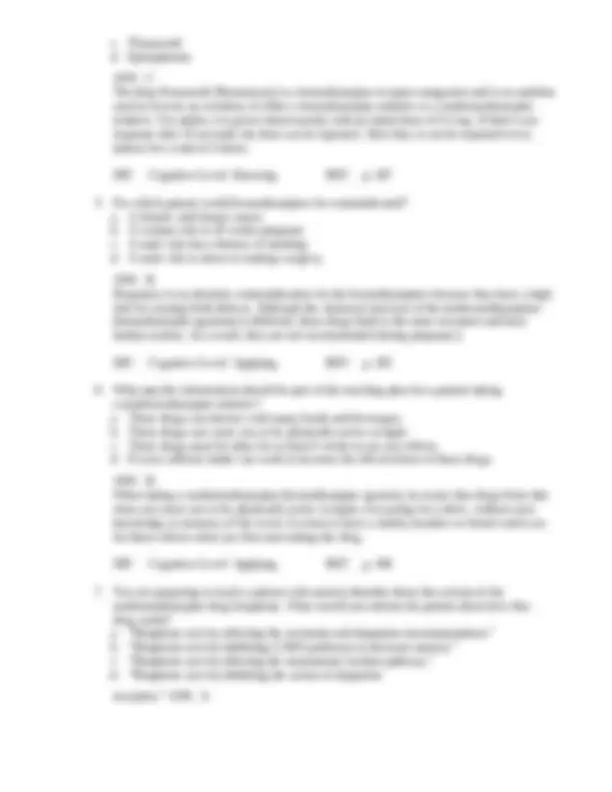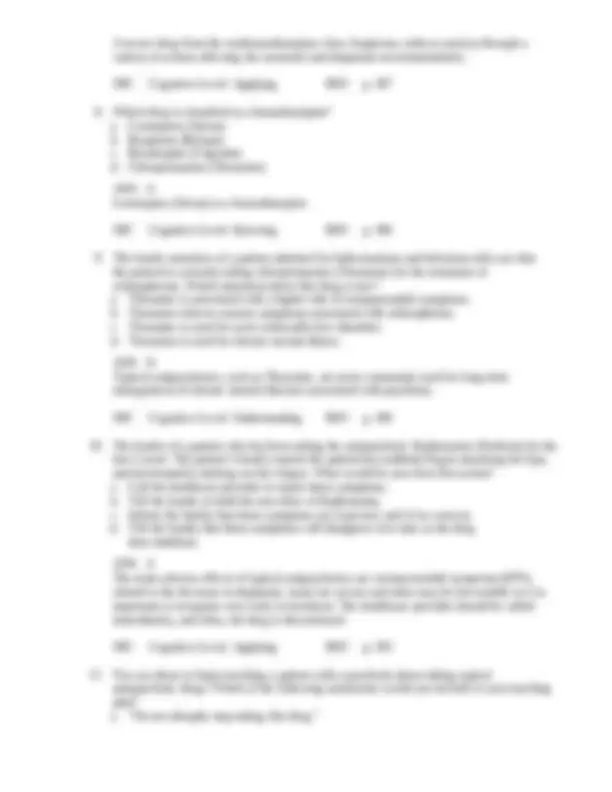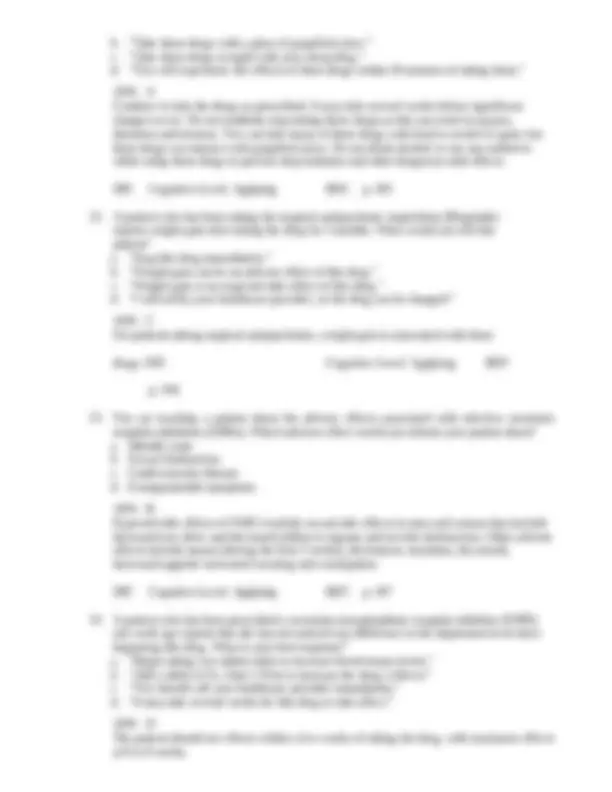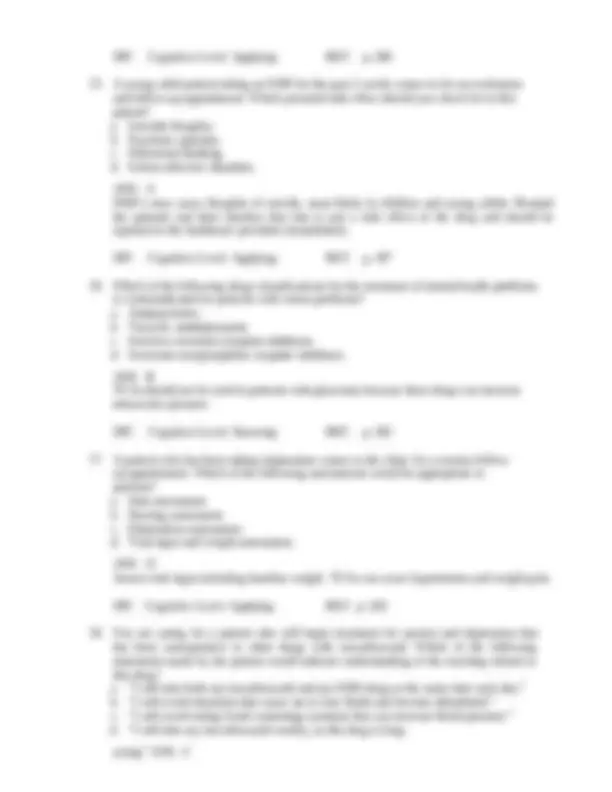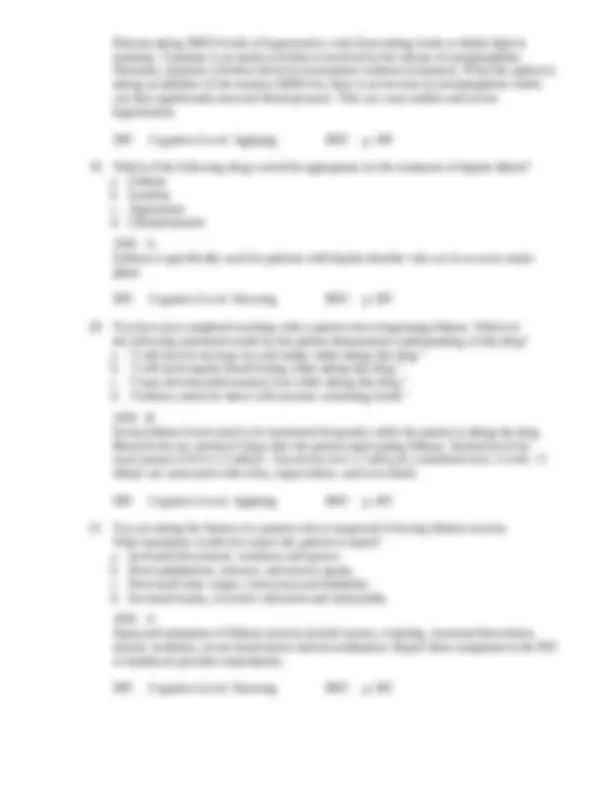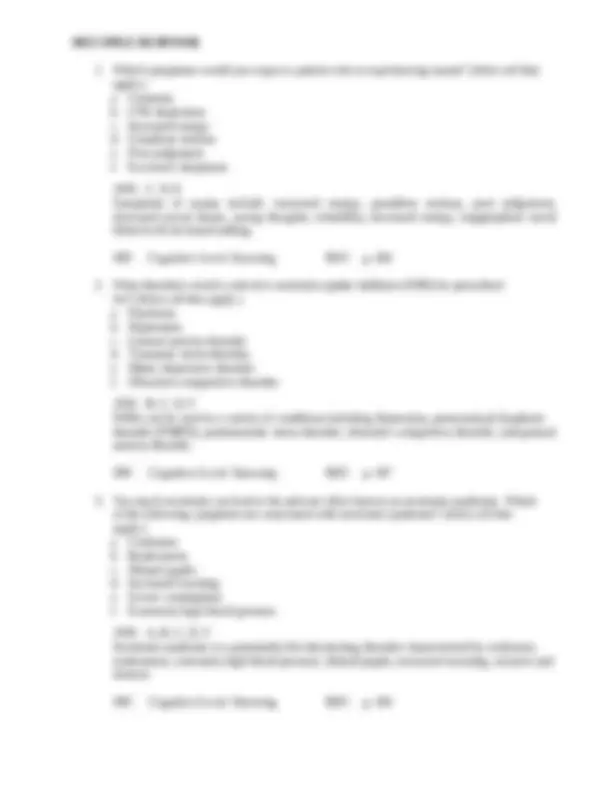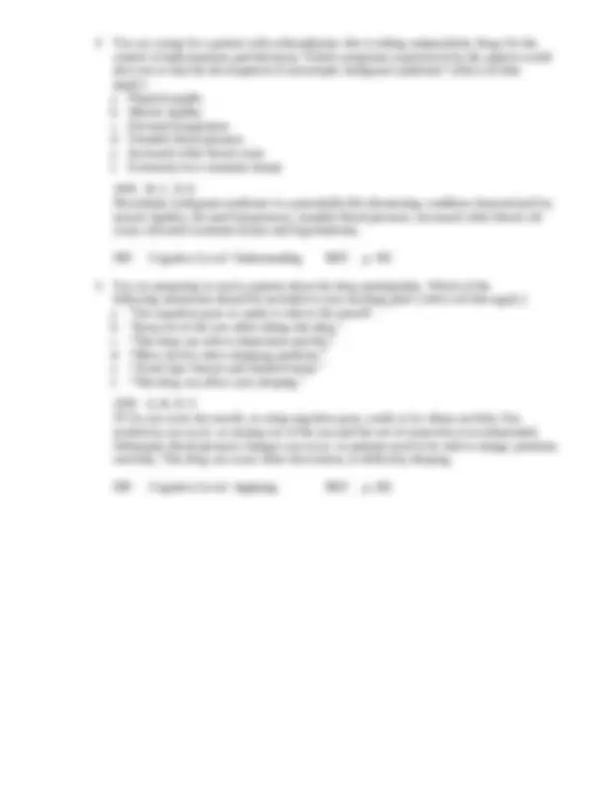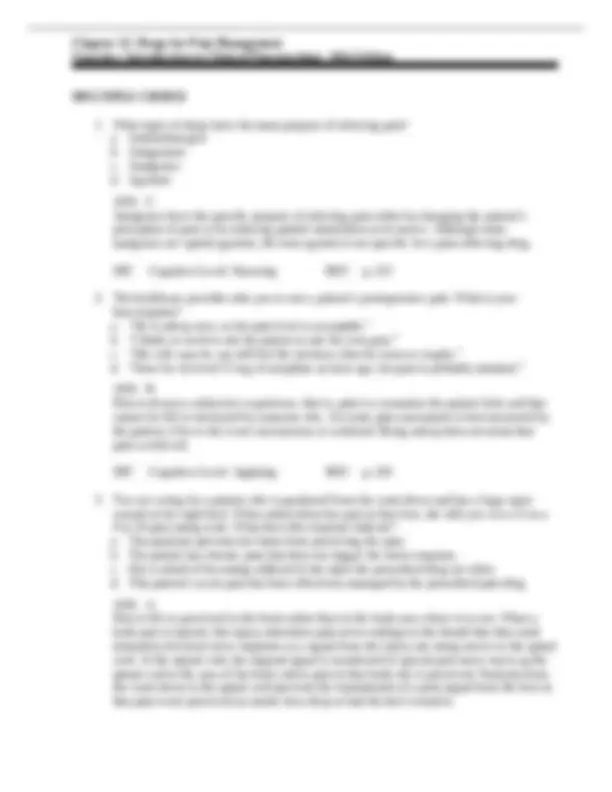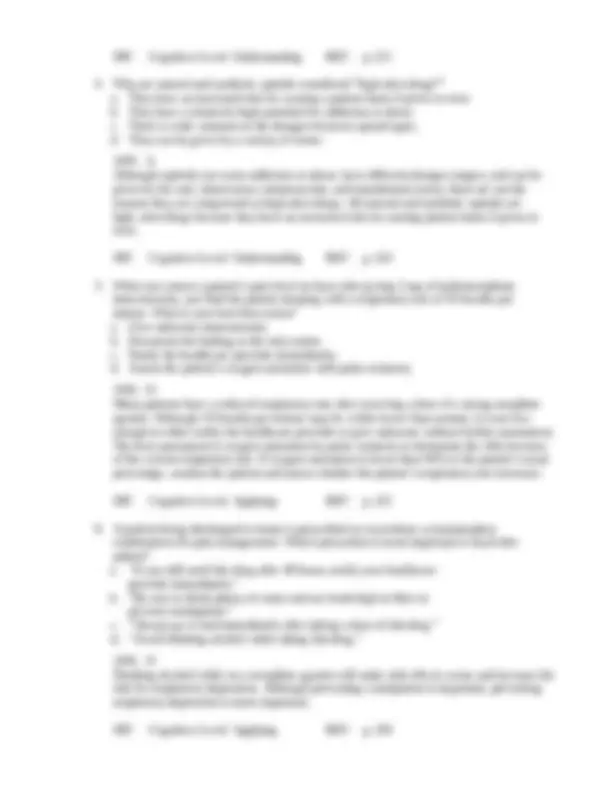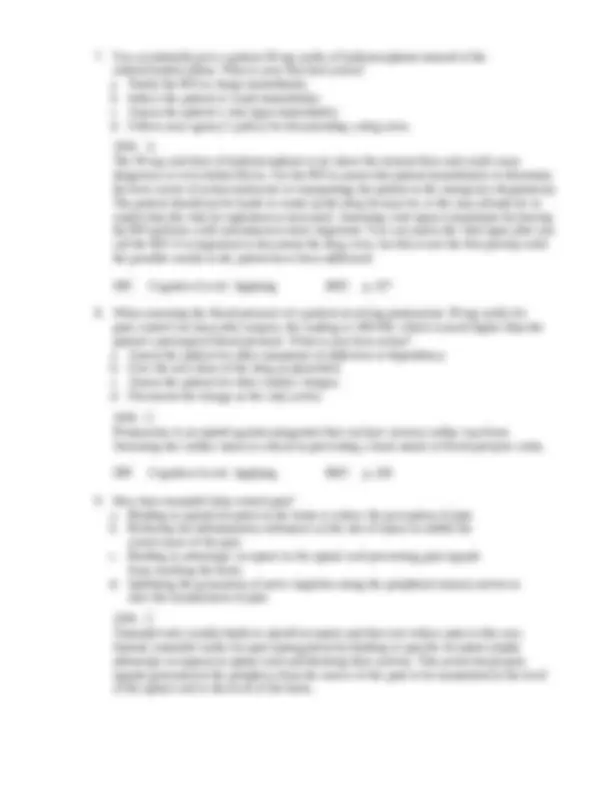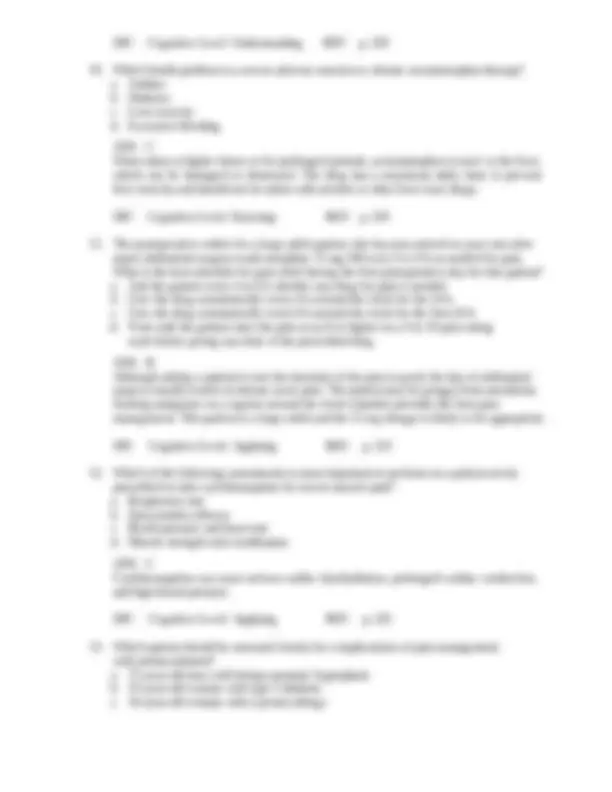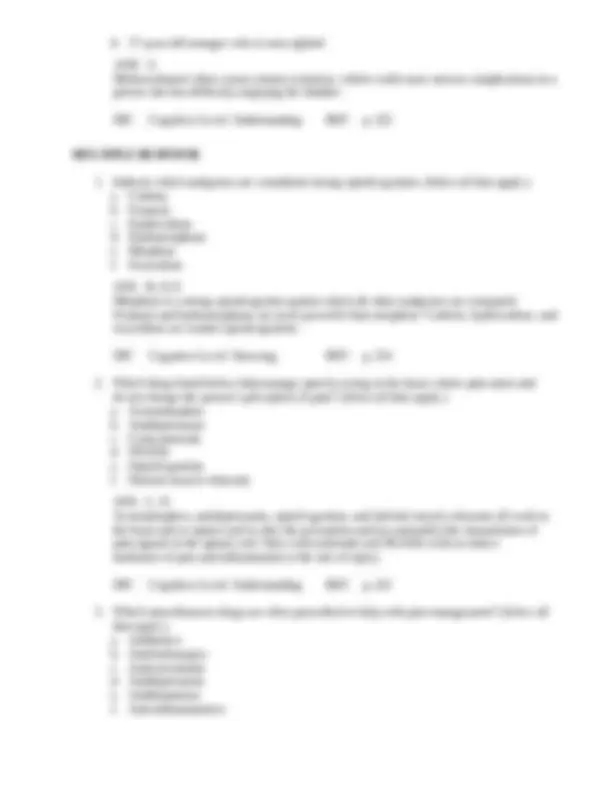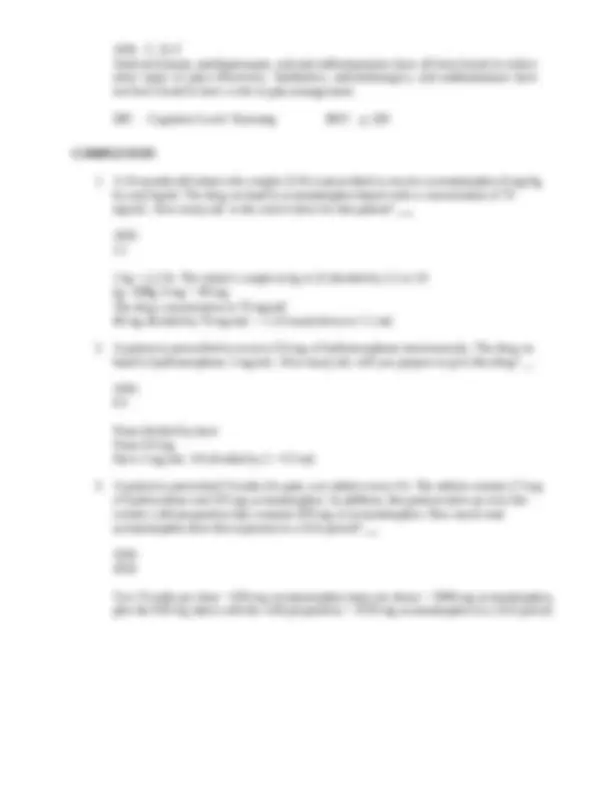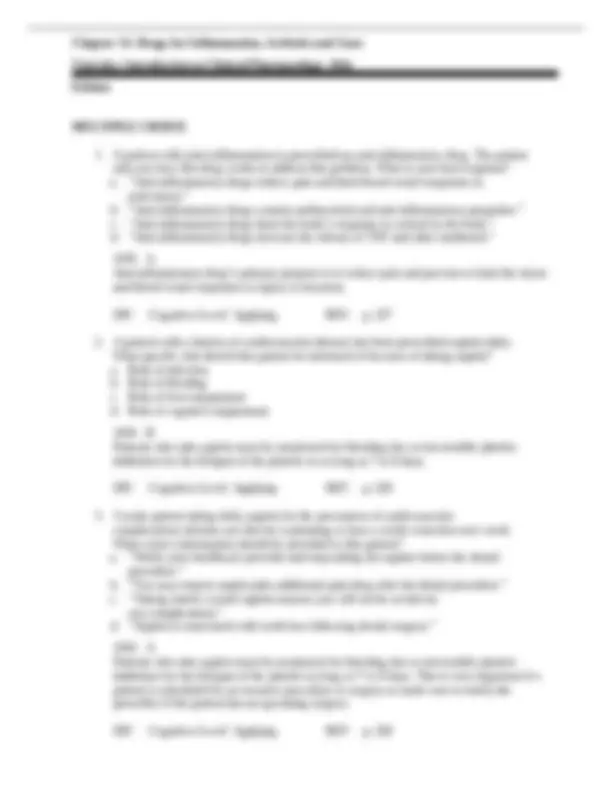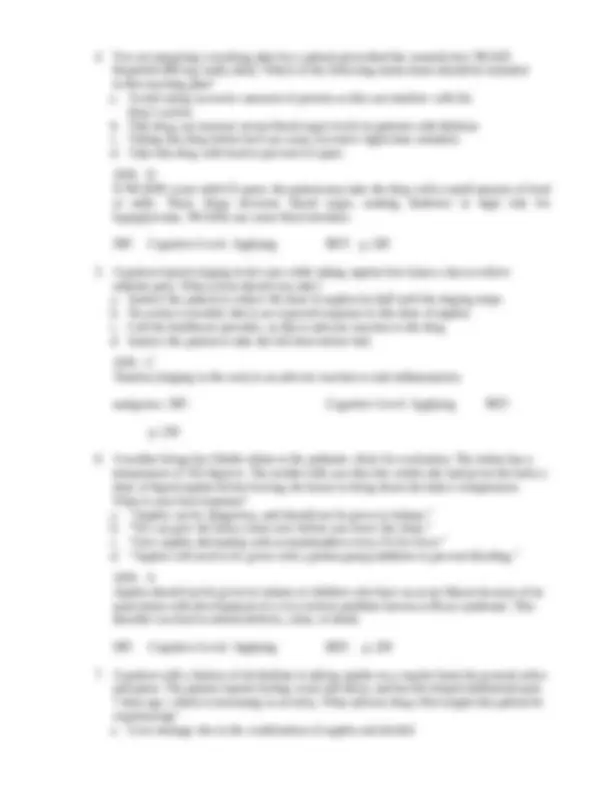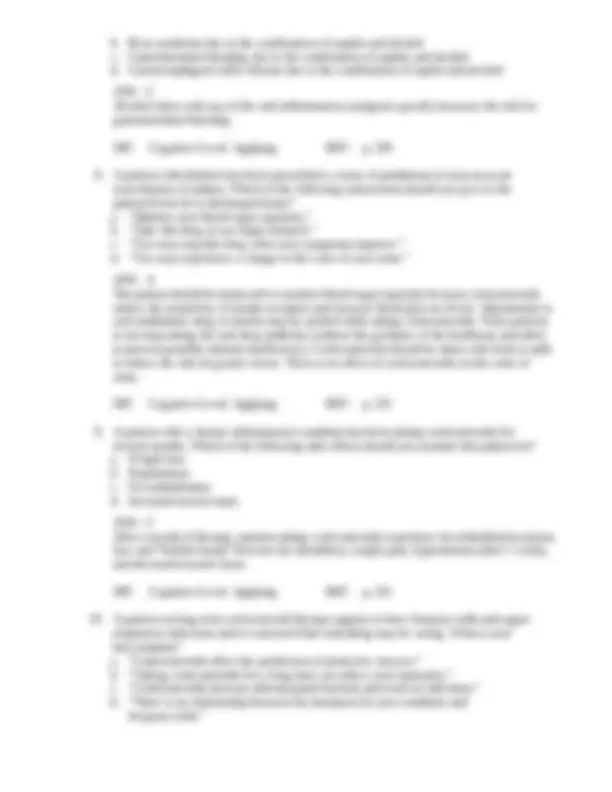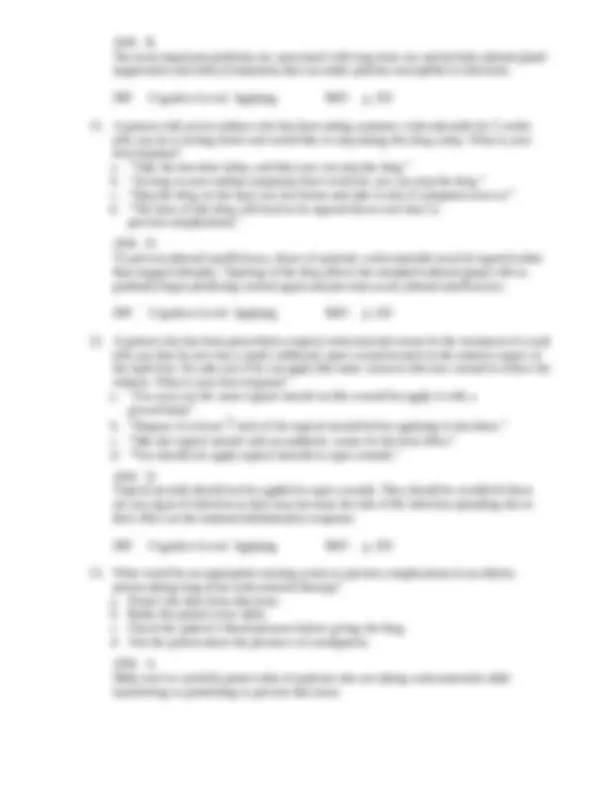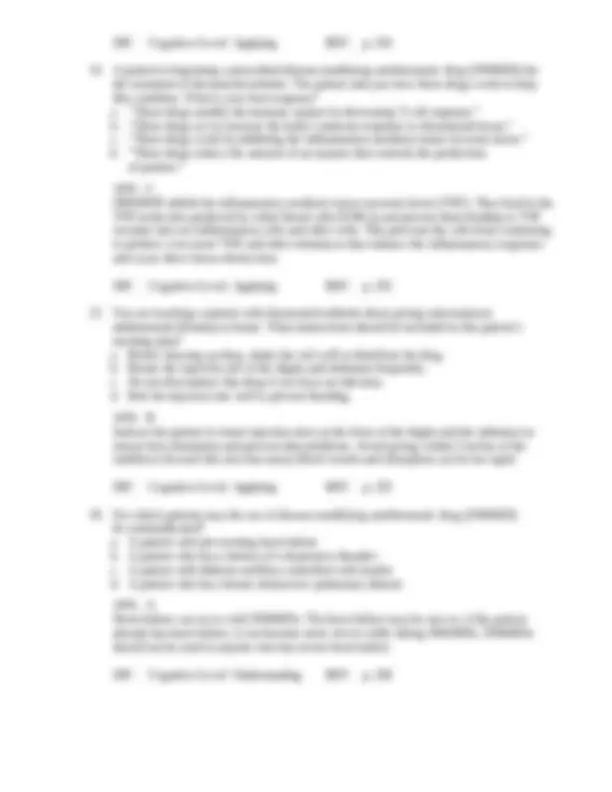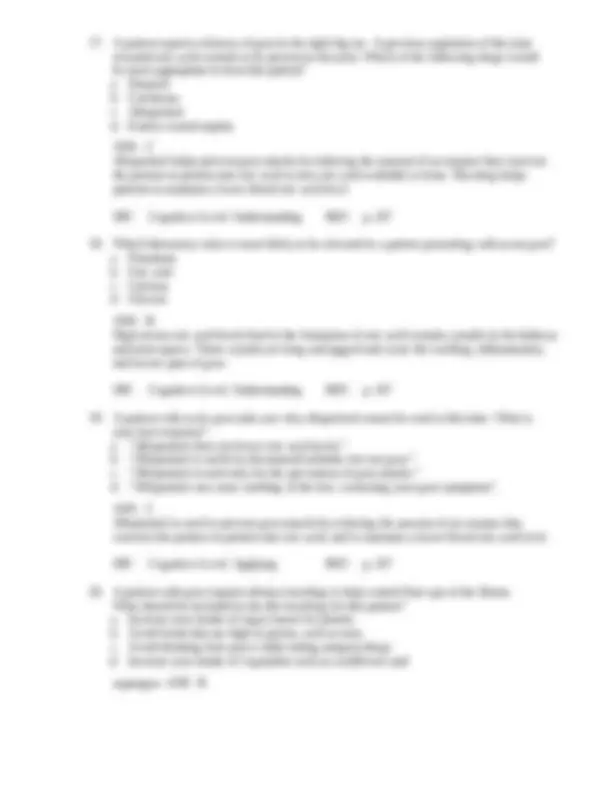Download Introduction to Clinical Pharmacology 10th Edition Test Bank by Constance Visovsky.docx and more Exams Nursing in PDF only on Docsity!
TEST BANK
Introduction to Clinical Pharmacology 10th Edition
TEST BANK
Introduction to Clinical Pharmacology 10th Edition Test Bank by Constance Visovsky, Cheryl Zambroski, and Shirley Hosler Table of Content Unit I: General Principles
- Pharmacology and the Nursing Process in LPN Practice
- Legal, Regulatory, and Ethical Aspects of Drug Administration
- Principles of Pharmacology Unit II: Principles of Medication Administration
- Drug Calculation: Preparing and Administering Drugs Unit III: Drug Categories
- Drugs for Bacterial Infections
- Drugs for Tuberculosis, Fungal and Parasitic Infections
- Drugs for Viral and Retroviral Infections
- Drugs for Allergy and Respiratory Problems
- Drugs Affecting the Renal/Urinary and Cardiovascular Systems
- Drugs for Central Nervous System Problems
- Drugs for Mental Health
- Drugs for Pain Management
- Drugs for Inflammation, Arthritis and Gout
- Drugs for Gastrointestinal Problems
- Drugs Affecting the Hematologic System
- Drugs for Immunization and Immunomodulation
- Drugs for Osteoporosis and Hormonal Problems
- Drug Therapy for Diabetes
- Drugs for Eye and Ear Problems
- Over-the-Counter Drug Therapy
ANS: D Once the healthcare provider orders the drug, you must verify that the order is accurate. This is done by checking the drug chart or drug record with the healthcare provider’s original order. DIF: Cognitive Level: Remembering REF: p. 4
- What do the nine “rights” of drug administration include? a. (^) Right patient, drug, dose, route, time, reason, documentation, response, and right to refuse b. (^) Right drug, diagnosis, time, patient, route, drug history, documents, and right to refuse c. (^) Right drug, amount, route, time, nurse, reason, route, diagnosis, and documentation d. (^) Right dose, time, healthcare provider, patient, route, documentation, response, and drug ANS: A There are nine “rights” of drug administration: you must identify the right patient, give the right drug at the right dose, right route, right time, for the right reason, using the right documentation to record that the dose has been given, monitor the patient for the right response, and note that the patient has the right to refuse a drug. DIF: Cognitive Level: Remembering REF: p. 5
- Which action should you take to ensure that you are giving a drug to the right patient? a. (^) Verifying the drug record with the patient name on the chart b. (^) Verifying the patient’s room and bed number with the chart c. (^) Asking the patient to state his or her birthdate and Social Security number d. (^) Asking the patient to state their name and birthdate, and then checking the patients identification bracelet ANS: D Before giving any drug, two forms of patient identifications should be used to identify the correct patient. Each patient should be asked his or her name, and another form of identification, such as birthdate; then you should check the patient’s identification bracelet. DIF: Cognitive Level: Applying REF: p. 5
- Which category of drugs should be given exactly on schedule in order to maintain a consistent level of the drug in the body? a. (^) Steroids b. (^) Diuretics c. (^) Aspirin products d. (^) Anticoagulants ANS: D Certain drugs must be given at specific time interval (right time). Anticoagulants must be given at the same time each day to maintain a therapeutic blood level in order to prevent blood clots. DIF: Cognitive Level: Applying REF: p. 7
- Which nursing action is not appropriate when giving drugs to a patient?
a. (^) Leaving the drug at the patient’s bedside to take when he/she awakens b. (^) Asking the patient if he or she has any allergies to drugs c. (^) Checking a drug reference to verify the action of the drug d. (^) Explaining to the patient the possible side effects of the drug ANS: A It is never permissible to leave drugs at the patient’s bedside. As the nurse, you are responsible for witnessing the patient taking the drug(s), or documentation of the patient’s refusal. DIF: Cognitive Level: Applying REF: p. 10
- Which of the following nursing actions is an example of evaluating patient responses to drug therapy? a. (^) Documenting the fact that the patient refused the drug b. (^) Making sure you have assembled all necessary equipment c. (^) Taking the patient’s blood pressure before giving an antihypertensive d. (^) Taking the temperature of a patient an hour after giving an antipyretic ANS: D Evaluation is the process of determining the right response of the patient to the drug given. The correct response to an antipyretic is a reduction in fever. DIF: Cognitive Level: Knowing REF: p. 9
- Which statement is considered to be an example of objective data gathered in the assessment of a patient who will be receiving drugs for the treatment of an injury? a. (^) The patient’s skin is warm and dry to touch. b. (^) The patient tells you “I have pain in my lower back.” c. (^) The patient states he is having trouble catching his breath. d. (^) The patient checks off “no history of drug allergies” on the health form. ANS: A Objective data are physical findings the nurse can see during careful inspection, palpation, percussion, and auscultation. DIF: Cognitive Level: Knowing REF: p. 3
- You are interviewing a patient to obtain a current drug history. What information should be part of this report? a. (^) The color of each drug in pill form b. (^) The names and dosages of each drug c. (^) The major health conditions of the patient d. (^) The nursing diagnoses that come from the collected information ANS: B In the interview to obtain a current and accurate drug history, the names of each drug and, if possible, the dosage of each drug are recorded. DIF: Cognitive Level: Applying REF: p. 3
d. (^) Assist the RN as directed, as under the RN’s supervision, this practice is permitted. ANS: C You are never to give a drug prepared by another nurse, even during a busy time or during an emergency. To meet all the patient safety standards covered by the “9 Rights,” you are required to give only drugs you have prepared. DIF: Cognitive Level: Applying REF: p. 7
- You are evaluating the response of a patient 30 minutes after receiving an antihypertensive drug. Upon assessment of the patient’s blood pressure, you note the patient has become hypotensive. What type of drug effect is this patient experiencing? a. (^) An adverse effect of the drug b. (^) A side effect of the drug c. (^) A therapeutic effect of the drug d. (^) An allergic reaction to the drug ANS: A An adverse effect is seen when patients do not respond to drugs in the way they should, or develop new signs or symptoms. When a patient has an adverse effect, you should report this immediately to the RN or healthcare provider. DIF: Cognitive Level: Knowing REF: p. 9 MULTIPLE RESPONSE
- Before giving a drug to a patient which steps should you take to ensure safe drug administration? ( Select all that apply .) a. (^) Use two forms of patient identification. b. (^) Ask the patient about any drug allergies. c. (^) Check the drug before removing it from the unit-dose cart. d. (^) Check the dose before preparing or measuring the drug. e. (^) Check the drug just before you open it and give it to the patient. f. (^) Document the drug given before you enter into the patient’s room. ANS: A, B, C, D, E The nurse needs to use two forms of identification to ensure the drug is given to the right patient. The nurse should read the drug label at least three times: (1) before taking the drug from the unit-dose cart or shelf, (2) before preparing or measuring the prescribed dose of drug, and (3) before giving it to the patient. Asking about drug allergies is important if this information is not available, or if drugs associated with allergic reactions, such as antibiotics, are given. DIF: Cognitive Level: Applying REF: p. 10
- You are taking the drug history from a patient. Which of the following information should be collected as part of this interview? ( Select all that apply. ) a. (^) Allergies to any drugs b. (^) Alcohol or recreational drug use c. (^) The time of day preferred for taking drugs d. (^) The use of nutritional supplements or herbs
e. (^) The strategies you will use to care for the patient f. (^) The illness or symptoms for which the drug is needed ANS: A, B, D, F The patient’s drug history consists of symptoms or diseases for which a drug is needed, the names, and dosages of all drugs, alcohol or recreational drug history, and alternative treatments, such as nutritional or herbal therapies. DIF: Cognitive Level: Applying REF: p. 3
- When evaluating a patient’s response to s drug, which factors should you should consider? ( Select all that apply. ) a. (^) The clarity of all written drug orders b. (^) The expected side effects of the drug c. (^) The reason the drug was prescribed d. (^) The therapeutic effects of the drug e. (^) The timing of the prescribed drug f. (^) The adverse effects of the drug ANS: B, D, E The three factors to be considered in evaluating responses to drug therapy are the therapeutic effects, expected side effects, and adverse effects. DIF: Cognitive Level: Remembering REF: p. 9
- As you arrive to work, a nurse from the previous shift tells you that she has completed the narcotic count for your shift. What action should be taken? a. (^) There is no need for any additional action as this is the standard procedure. b. (^) Accept the keys to the narcotic cabinet and recount the drugs yourself. c. (^) Recount the narcotics again with a nurse from the previous shift. d. (^) Recount the drugs yourself at the end of your shift. ANS: C At the end of each shift, the contents of the locked cabinet are counted together by one nurse from each shift in order to verify the narcotics count. If not done properly, the nurse risks being held accountable for any shortages or discrepancies, and may be found guilty of falsifying the narcotic count records. DIF: Cognitive Level: Applying REF: p. 14
- A one-time order for a controlled substance drug has been written for a patient you are caring for. However, the drug ordered is available only in a larger dose than is needed. What should you do with the remaining drug? a. (^) Give the full dose that is available. b. (^) Flush the remaining drug in the toilet of the patient’s bathroom. c. (^) Save the remaining drug in case the patient needs it again. d. (^) Have another nurse witness the wasting of the leftover drug, and document according to policy. ANS: D If the ordered dose is smaller than the dose provided (so that some drug must be discarded), two nurses witness the wasting of the drug and sign the controlled substance inventory report according to institution policy. DIF: Cognitive Level: Knowing REF: p. 14
- An elderly patient in an assisted living home requests an over-the-counter cough preparation for a mild couch she is experiencing. What is your best response? a. (^) “I do not have any of this drug for you at this time, but can give you a dose from another patient’s supply.” b. (^) “I will bring it to you right away, but I must keep it with your other prescription drugs.” c. (^) “I will need to contact your healthcare provider for an order before I can give this drug to you.” d. (^) “You may have this, but your family will need to bring it in for you.” ANS: C Over-the-counter (OTC) drugs do not require a prescription for purchase, but a healthcare provider’s order is required before it can be given by the LPN/LVN in an institutional setting. OTC drugs may interact with a patient’s prescribed drugs, especially in the elderly. DIF: Cognitive Level: Applying REF: p. 15
- Which of the following orders is an example of a single drug order?
a. (^) Atenolol 50 mg orally daily b. (^) Morphine sulfate 4 mg IV stat c. (^) Cefazolin 1 g IV 8 a.m. before surgery d. (^) Tramadol 50 mg orally as needed for pain ANS: C A single drug order is a drug that is scheduled to be given at a specified time for one dose only. DIF: Cognitive Level: Knowing REF: p. 16
- Diphenhydramine 50 mg IV push is ordered by the healthcare provider to be given “ stat .” When should this drug be given? a. (^) Immediately b. (^) As need upon the patient’s request c. (^) Within one hour of receiving the order d. (^) When you have completed giving the oral drugs first ANS: A A stat order is a type of drug order that is to be given immediately. DIF: Cognitive Level: Knowing REF: p. 16
- You are giving drugs to the patients assigned to you when you realize that you gave a drug to the wrong patient. What action should you take? a. (^) Evaluate the patient’s condition and notify the healthcare provider. b. (^) Submit a report only if the patient has an adverse reaction. c. (^) Inform the patient and complete an incident report. d. (^) Document the occurrence in the patient record. ANS: A When it is discovered that an error has been made, you should immediately evaluate the patient for any adverse reactions and notify the healthcare provider as soon as possible. An incident report should be completed and the supervisor notified. DIF: Cognitive Level: Applying REF: p. 19 MULTIPLE RESPONSE
- Which of the following drugs is considered a high-alert drug? ( Select all that apply. ) a. (^) Percocet b. (^) Insulin c. (^) Heparin d. (^) Herceptin e. (^) Potassium f. (^) Indomethacin ANS: B, C, E
e. (^) Institutional Regulations f. (^) Health Insurance Regulations ANS: B, D, E Nurses who are responsible for giving drugs to patients in their care have three levels of regulations to follow: federal (describes and controls), state (regulates who dispenses), and individual hospital or agency (additional guidelines or policies). DIF: Cognitive Level: Remembering REF: pp. 14- 16
- A narcotic control system is used in any hospital or agency. Which of the following are special regulations applied for control of narcotics that you must follow? ( Select all that apply. ) a. (^) Narcotics are stored in a special locked cabinet. b. (^) Narcotic control is the responsibility of everyone on the unit. c. (^) Narcotics may be borrowed from patient to patient for emergency use. d. (^) You may return unused narcotics to the patient’s family upon discharge. e. (^) You are responsible for signing out every narcotic drug used for a patient. f. (^) An inventory of the narcotics on a unit must be kept and verified by two nurses. ANS: A, E, F Narcotics are stored in special, limited-access, locked cabinets. A nurse records all controlled substance drug during the shift. The inventory report form is completed before the drug is removed from the cabinet. DIF: Cognitive Level: Applying REF: pp. 12- 13
- A discrepancy in the narcotics inventory for morphine 5 mg/mL vials is discovered when the narcotics count is performed. The count is short by one vial. Which of the following steps should you take to reconcile the count? ( Select all that apply .) a. (^) No action needs to be taken for small discrepancies. b. (^) Notify the nursing supervisor and the pharmacy of the discrepancy. c. (^) Identify if any nurse forgot to record any of the narcotics removed. d. (^) Ask only the nurses who used narcotics about the drugs they have given. e. (^) Check drug records to reconcile if narcotics given and not signed for. f. (^) Notify the security department of the institution if drug diversion is suspected. ANS: B, C, E, F All nurses must be asked about narcotics that may have been given. Steps must be retraced to see if someone forgot to record any drug. Patient charts might also be checked to see if drug was given that was not signed for on the inventory report. If errors in the report cannot be found, both the pharmacy and the nursing service office must be notified. If drug diversion is suspected, the hospital administrator and security police are usually contacted. DIF: Cognitive Level: Applying REF: pp. 12- 14
Chapter 03: Principles of Pharmacology
Visovsky: Introduction to Clinical Pharmacology, 10th Edition
MULTIPLE CHOICE
- Which is always true regarding the generic name for a drug? a. (^) It is the same in any country. b. (^) It is capitalized when written. c. (^) It is similar to the chemical name. d. (^) It is assigned by a specific manufacturer. ANS: A The generic name is the common drug name used. This name is the same in all countries. The generic drug name is written in lower-case letters, whereas the trade name or brand name of a drug is capitalized. DIF: Cognitive Level: Remembering REF: p. 23
- What is the difference between the generic and the trade names of drugs? a. (^) The generic name is approved and owned by the Federal Drug Standards Committee. b. (^) The generic name represents the proprietary name given by a drug company. c. (^) The trade name is one that is registered to a specific drug manufacturer. d. (^) The trade name, or chemical name, represents the chemicals in the drug. ANS: C The trade name is the proprietary or brand name for the drug, and is registered to a specific drug company. DIF: Cognitive Level: Remembering REF: p. 23
- Which statement is true about the way drugs and receptor sites work? a. (^) The drug attaches to a receptor site and activates it. b. (^) The drug prevents activation of the receptor site. c. (^) The receptor site is activated, allowing DNA replication to occur. d. (^) The receptor sites are activated once the drug leaves the receptor site. ANS: A The drug attaches to the receptor site and activates the receptor. DIF: Cognitive Level: Knowing REF: p. 23
- What response would you expect in a patient given a drug that is considered an antagonist? a. (^) Positive and negative activation of cell receptors b. (^) A complete activation of cell receptors c. (^) A partial activation of cell receptors d. (^) No activation of cell receptors ANS: D
d. (^) Sublingual tablet ANS: B Drugs injected intravenously into the bloodstream have the fastest action. DIF: Cognitive Level: Remembering REF: p. 24
- What is the process by which molecules move from a region of higher concentration to one of lower concentration? a. (^) Diffusion b. (^) Osmosis c. (^) Filtration d. (^) Solubility ANS: A In diffusion, molecules move from a region of higher concentration to one of lower concentration. DIF: Cognitive Level: Remembering REF: p. 25
- A 62-year old male patient with liver disease asks you why he is receiving a drug intravenously rather than by mouth. What is your best response? a. (^) “Many oral drugs are inactivated as you get older.” b. (^) “Your liver disease impairs the transformation of a drug into its active form.” c. (^) “Intravenous drugs reduce toxicity to the liver through first-pass metabolism.” d. (^) “Individuals with liver disease have a genetic impairment that prevents drug activation.” ANS: B Many drugs must be activated by enzymes before they can be used in the body. This biotransformation happens in the liver. Liver disease impairs this process. DIF: Cognitive Level: Applying REF: pp. 25- 26
- A patient who is beginning a new cholesterol-lowering drug tells you he plans to take this drug in the evening with his usual glass of grapefruit juice. What is your best response? a. (^) “The vitamin C in grapefruit juice enhances the action of cholesterol- lowering drugs.” b. (^) “The acid environment of grapefruit juice promotes drug metabolism.” c. (^) “Taking grapefruit juice can reduce the effectiveness of the drug.” d. (^) “Taking grapefruit juice can increase the absorption of the drug.” ANS: C Grapefruit juice affects (usually reduces) the absorption of many drugs such as antihistamines, cholesterol-lowering drugs, HIV drugs, and transplant drugs. DIF: Cognitive Level: Applying REF: p. 26
- You give a patient 400 mg of an oral drug at noon. This drug has a half-life of 2 h. At what time will 100 mg remain?
a. (^) 2:00 p.m. b. (^) 6:00 p.m. c. (^) 8:00 p.m. d. (^) 4:00 p.m. ANS: D With a half-life of 2 h, the amount of drug remaining in the blood decreases by 50% every 2 h. So, when 400 mg are given at noon, by 2:00 p.m., 200 mg remain; by 4:00 p.m., 100 mg remain. DIF: Cognitive Level: Understanding REF: p. 26
- When teaching a patient about a new drug that has been prescribed, the patient asks you to explain the difference between a side effect and an adverse reaction. What is your best response? a. (^) Both side effects and adverse reactions are mild. b. (^) Both side effects and adverse reactions are severe. c. (^) Side effects are mild, and adverse effects are severe. d. (^) Side effects are severe, and adverse reactions are mild. ANS: C Side effects are usually seen as mild but annoying responses to a drug. Adverse reactions, or adverse effects, usually imply more severe symptoms or problems that develop because of the drug. DIF: Cognitive Level: Applying REF: p. 27
- A patient tells you that she is experiencing sleepiness after taking a drug prescribed for back pain. What is your best response? a. (^) “You are having a severe drug interaction.” b. (^) “You are having an expected drug side effect.” c. (^) “You are having the desired effect of this drug.” d. (^) “You are having an idiosyncratic response to this drug”. ANS: B Drugs may influence many body systems at the same time, so the effect of the drug is often not restricted to the desired action. Side effects are usually seen as mild but annoying responses to the drug. In the case of many drugs for pain, sleepiness is an expected side effect. DIF: Cognitive Level: Applying REF: p. 27
- A patient who was given intravenous penicillin for a severe infection develops hives, itching, and facial swelling immediately after the infusion. What type of drug reaction is this patient experiencing? a. (^) An adverse reaction b. (^) A paradoxical reaction c. (^) An anaphylactic reaction d. (^) A hypersensitivity reaction ANS: D
- You are caring for a patient with liver failure who will be starting on an anticoagulant for the treatment of a deep vein thrombosis. What effect of this drug should you expect? a. (^) The effect of the anticoagulant will be prolonged and pose a risk for bleeding. b. (^) The effect of the anticoagulant will be reduced, requiring additional doses. c. (^) The effect of the anticoagulant will result in an increased risk for infection. d. (^) There will be no effect of the anticoagulant on the deep vein thrombosis. ANS: A A patient with liver or the kidney disease will retain a drug much longer, increasing the risk for adverse and toxic effects. In the case of an anticoagulant, the risk for bleeding is increased in a patient with liver disease. DIF: Cognitive Level: Applying REF: p. 29
- Which statement concerning absorption of oral drugs is true for neonates? a. (^) Oral prodrugs are activated most quickly in the neonate. b. (^) Oral drugs are poorly absorbed for the gastrointestinal tract of the neonate. c. (^) The overall low body metabolism results in increased toxicity in the neonate. d. (^) The high percentage of total body water rapidly dilutes oral drugs in the neonate. ANS: B In neonates oral drugs are absorbed poorly from the GI tract because no gastric acid is present to help break down drugs, no intestinal bacteria or enzyme function is present to metabolize a drug, and the time it takes for a drug to move through the stomach and intestines is slow. DIF: Cognitive Level: Knowing REF: p. 30 MULTIPLE RESPONSE
- Which of the following factors are known to influence drug distribution? ( Select all that apply. ) a. (^) Tissue type b. (^) Drug binding c. (^) Tissue perfusion d. (^) Receptor site binding e. (^) Electron displacement f. (^) Cell membrane penetration ANS: A, B, C, F Distribution of the drug depends upon tissue (perfusion), types of tissue (bone, fat, and muscle) and how easy it is for the drug to penetrate the cell membranes. Some drugs will also bind together with many blood substances and proteins such as albumin. This binding allows only “free” drug (that which is not bound) to penetrate the tissues. DIF: Cognitive Level: Remembering REF: p. 30
- Which of the following routes are sites of excretion of drug metabolites from the body? ( Select all that apply. ) a. (^) Feces
b. (^) Urine c. (^) Breast milk d. (^) Bloodstream e. (^) Lymph nodes f. (^) Salivary glands ANS: A, B, C All inactive chemicals, chemical by-products, and waste (metabolites) finally break down through metabolism and are removed from the body through the process of excretion in feces, urine, and breast milk. DIF: Cognitive Level: Knowing REF: pp. 31- 32
- What are the possible responses a patient can have to a drug’s actions? ( Select all that apply. ) a. (^) Desired action b. (^) Bioequivalence c. (^) Adverse effects d. (^) Side effects e. (^) Half-life f. (^) Onset ANS: A, C, D When a drug is given to a patient, the expected response of the drug is called the desired action. Other responses to drugs include side effects and adverse effects. DIF: Cognitive Level: Applying REF: p. 27
- Which of the following issues related to drug therapy in the older patient are true? ( Select all that apply. ) a. (^) Drugs are secreted more slowly in older patients. b. (^) Drug interactions are far less prevalent in older patients. c. (^) Adverse drug reactions are more common in older patients. d. (^) Dehydration can cause the blood level of drug to increase in older patients. e. (^) Fat-soluble drugs are eliminated, and leave the body quickly in older patients. f. (^) Loss of electrolytes due to diuretics can result in loss of electrolytes in older patients. ANS: A, C, D, F Drugs are absorbed, metabolized, and excreted more slowly and less completely in older adults. Adverse drug reactions (ADRs) are common in older adults. Issues such as falls, hypotension, delirium, kidney failure, and bleeding are common clinical manifestations. Older adult patients may become dehydrated easily, thus allowing the amount of drug in the blood to increase. Diuretics lead to an increase in urination and this can lead to loss of electrolytes. DIF: Cognitive Level: Knowing REF: p. 30

